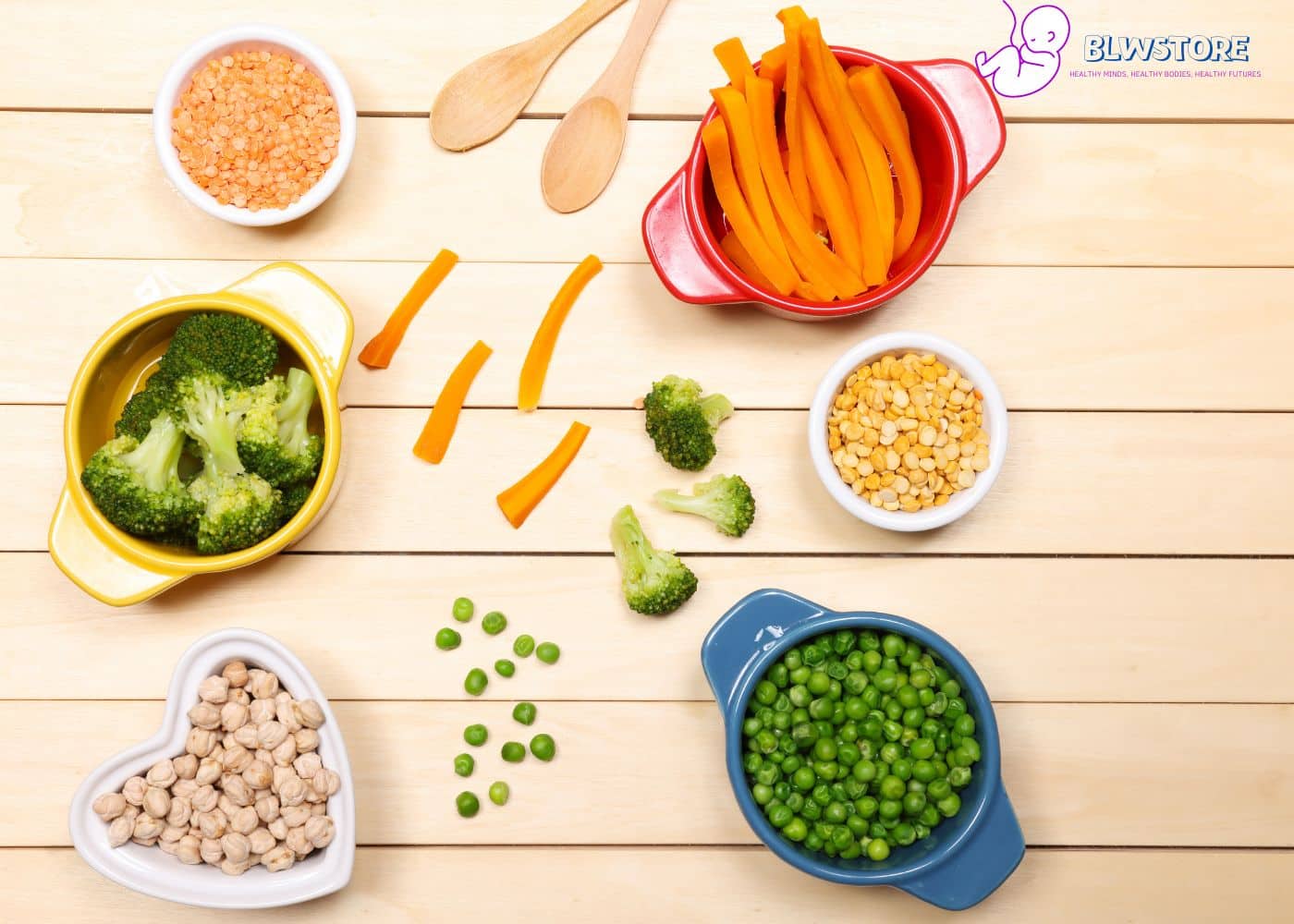
Welcome to our Baby-Led Weaning Guide!
This comprehensive guide will help you navigate the world of BLW, providing valuable insights into the foods suitable for your baby’s meal plan, including fruits, vegetables, grains, legumes, and proteins.
Discover the most effective cooking methods for baby-led weaning and learn how to design a well-rounded meal plan that is both nutritious and safe.
We recommend you check out Baby-led Weaning Meal Plan Generator for unlimited meal ideas!
Without further ado, let’s get after it!
*Related reads: Best Proteins for Babies | Best Carbs for Babies | Best Fats for Babies
What is Baby Led Weaning?
Baby-Led Weaning (BLW) is a method of introducing solid foods to infants that focuses on self-feeding and the exploration of various textures and flavors. Rather than being spoon-fed pureed foods, babies in BLW are given soft, easy-to-grasp pieces of food that they can pick up and eat independently. This approach promotes the development of fine motor skills, taste preferences, and autonomy while minimizing choking risks.
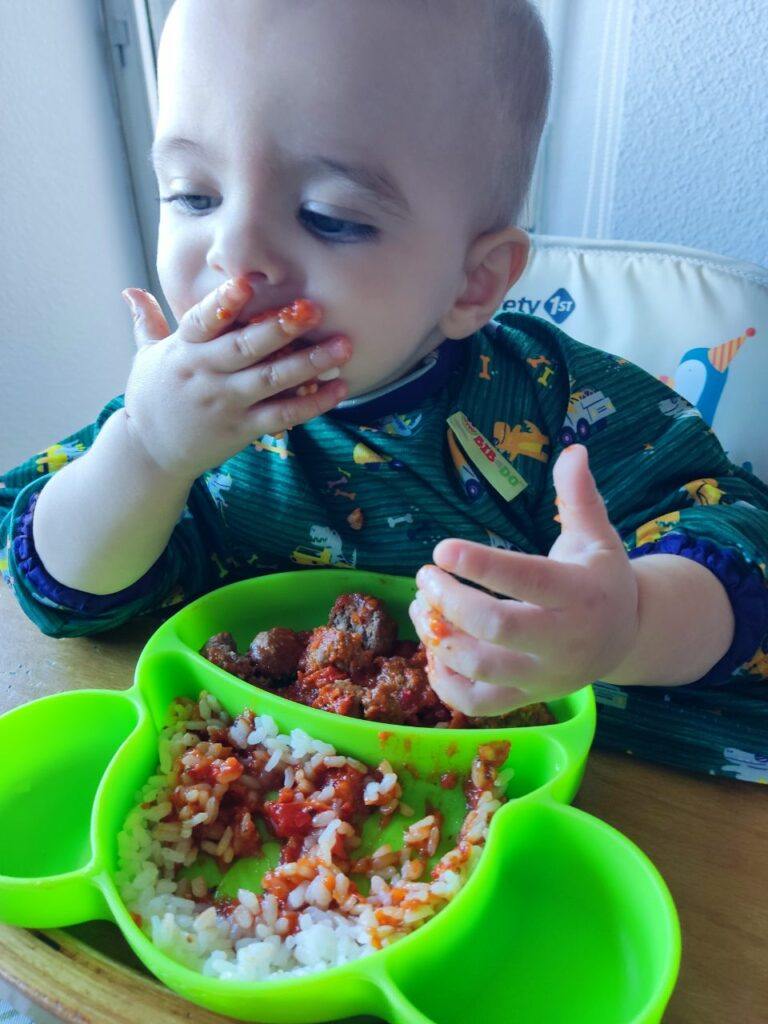
What age should I start baby led weaning?
Each baby’s ideal starting age for baby-led weaning will be different. Still, usually, it is advised to begin between 6 and 12 months of age.
The World Health Organization recommends that babies start eating solid meals at about six months of age when they have acquired the motor abilities and coordination required for self-feeding.
The baby’s developmental milestones, such as sitting up unassisted, controlling their head and neck, and displaying an interest in food, should also be considered.
The baby should also be able to move food around in their mouths, pick up and hold food, and be willing to chew, among other indications that they are ready for solid food.
If you have doubts, talk to your pediatrician before introducing solid foods. They can offer tailored advice based on your baby’s particular developmental needs.
How to start BLW
Starting Baby-Led Weaning can be an exciting and rewarding experience for both baby and parent. Here are some critical steps to follow when introducing solid foods to your baby:
- If you need to, consult your pediatrician to ensure your baby is developmentally ready for solid foods, usually around six months.
- Prepare a safe and comfortable feeding environment by adjusting the highchair straps and footrests as needed.
- Introduce water alongside solid food to help the baby learn to drink from an open cup.
- Start with a single food at a time and offer a variety of textures and flavors. Soft, cooked fruits and vegetables, and small pieces of mild protein, such as meat or eggs, are good options.
- Allow your baby to explore and self-feed the food, and don’t force them to eat if they do not want to continue.
- Remember that every baby is different; some may take longer to adjust to solid foods. It’s ok to take a break and try again later if your baby is not showing interest.
It’s also important to always supervise your baby during mealtime to ensure their safety and be attentive to any signs of choking.
Finally, relax and enjoy the process, as it can be a bonding time for you and your baby.
| Recommended Practices | Not-Recommended Practices |
|---|---|
| Consult with a pediatrician before starting solid foods | Start solid foods before your baby is developmentally ready |
| Introduce a variety of textures and flavors | Offer only one type of food for too long |
| Allow your baby to self-feed and explore food | Force-feed or coerce your baby to eat |
| Support your baby’s natural hunger and fullness cues | Pressure your baby to eat more than they want |
| Sit with your baby during mealtime and supervise their safety | Leave your baby alone while they are eating |
| Offer breastmilk or formula in addition to solid foods | Replace breastmilk or formula with solid foods too early |
| Allow for messiness and enjoy the experience | Worry too much about messes or spills |
| Adapt to your baby’s preferences, whether they prefer purees or finger foods | Insist on one particular feeding method |
What foods should I avoid while doing it?
We have a post exclusively on foods that should be avoided during BLW, but here are the ones you should watch out for:
- Whole nuts and seeds
- Raw carrots and apples
- Sphere shaped foods
- Corn kernels or popcorn
- Slippery foods
Avoid adding sugar and salt.
Dairy is not recommended since before 12 months; babies are not ready.
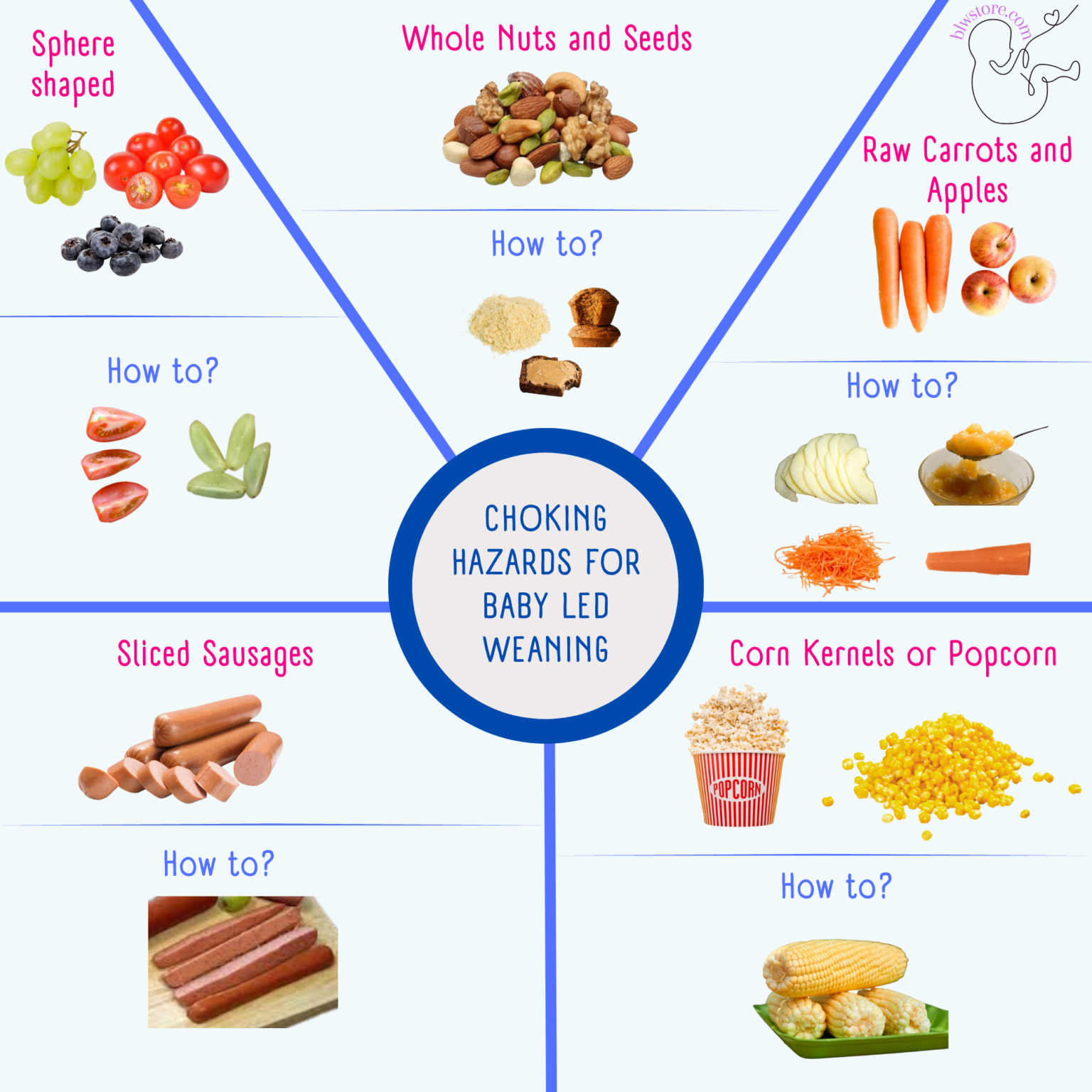
Gagging and Choking during BLW
Gagging and choking are common concerns when introducing solid foods through baby-led weaning. It is essential to understand that gagging is a normal reflex that helps babies move food around their mouths and learn to chew and swallow.
Gagging sounds can be alarming, but they typically do not indicate an actual choking episode.
It’s important to supervise your baby during mealtime and be familiar with the signs of choking and what to do in an emergency. However, it’s important to note that gagging is a normal and necessary part of learning to eat.
| Aspect | Gagging | Choking |
|---|---|---|
| What is it? | A natural reflex that prevents choking by pushing food forward | A serious obstruction of the airway caused by food or objects |
| Cause | Triggered by food touching the back of the tongue or throat | Food or an object blocking the airway |
| Frequency | Normal part of learning to eat solid foods | Less common but can be dangerous |
| Sound | Coughing or retching noise | Wheezing, high-pitched noises, or silent |
| Physical appearance | Reddened face, watering eyes, sticking out tongue | Blue or pale face, inability to breathe, cough, or cry |
| Duration | Brief and self-resolving | Requires immediate medical intervention |
| Proper response | Stay calm and allow the baby to work through the gag reflex | Perform first aid, such as back blows and chest thrusts |
| Prevention | Offer age-appropriate foods | Cut food into small pieces, avoid high-risk foods, supervise during mealtime |
How to cut foods in Baby-Led Weaning
When preparing foods for baby-led weaning, it is crucial to cut them into appropriate sizes and shapes that are easy for the baby to handle and pick up. Here are some guidelines to follow:
- Cut foods into finger-size pieces, about 4 inches long, so the baby can easily pick them up and explore the texture and flavor.
- Avoid cutting foods into small pieces, as babies under 9 months do not have the fine motor skills to pick up small items with a pincer grasp.
- Choose foods that have a firm texture and are not too slippery; this way, the baby can have a better grip on them. Some examples are bananas with some peel still on, avocado spears, roasted sweet potato wedges, roasted apple wedges, roasted broccoli florets, sautéed green beans, and melon slices.
- You can also offer more significant pieces of food if you are concerned about the size, such as half a slice of bread or a big chunk of watermelon.
- Always supervise your baby during mealtime and be attentive to any signs of choking.
What’s better, BLW or Purees?
We also have an article on the benefits of doing BLW instead of purees. However, it will depend on your preferences and the approach you feel more comfortable with.
As for our personal and professional opinion, we support the BLW method. It never hurts to try it first, and if you are uncomfortable, go with the puree route.
If you are not sure, read our comparison: BLW vs Purees
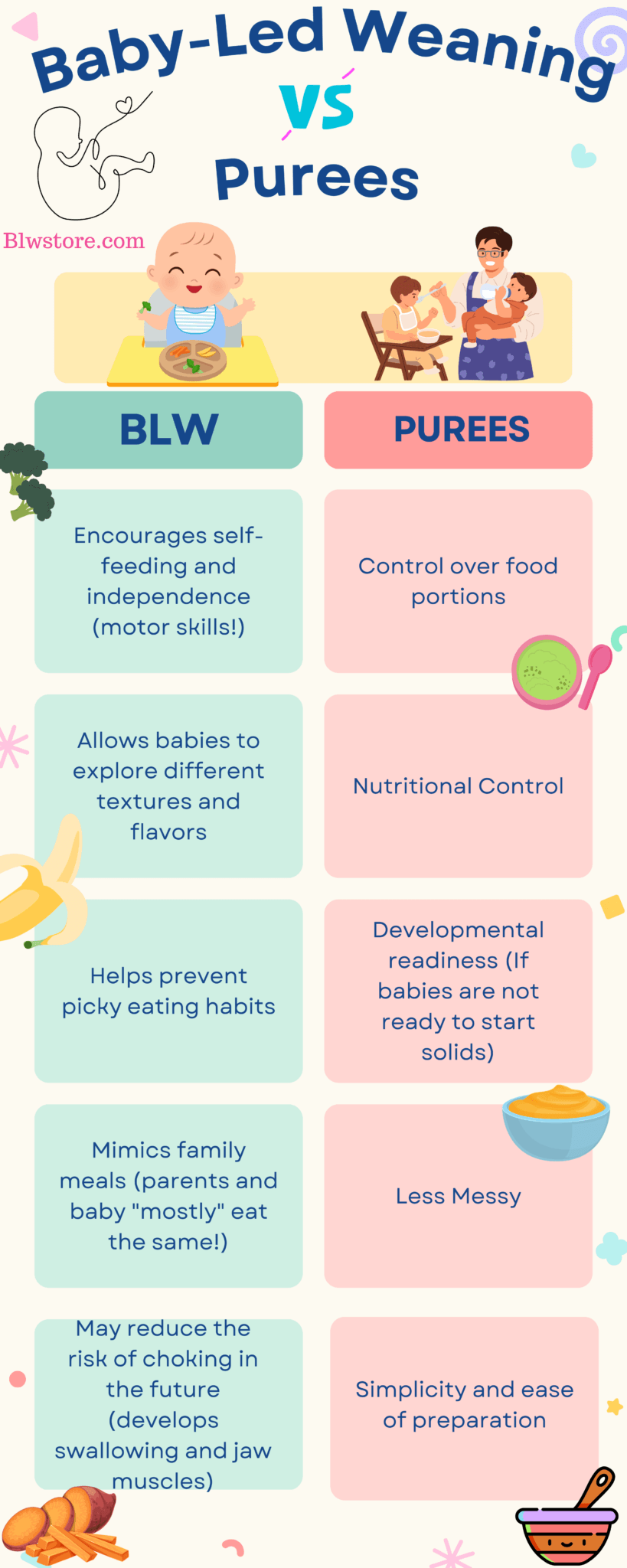
Can I mix purees with baby-led weaning?
As supporters of baby-led weaning, we believe that mixing purees with BLW can give parents the best of both worlds when introducing solid foods to their babies.
By allowing the baby to self-feed with finger foods and experimenting with purees through pre-loaded spoons, parents can provide a variety of textures and flavors for the baby to explore.
This can be especially helpful as babies learn to coordinate their hands and mouths and develop their fine motor skills. It is also important to note that as you and your baby become more experienced with BLW, you can gradually transition to exclusively doing BLW, giving your baby more freedom to explore and self-feed with finger foods.
How to introduce allergenic foods
Introducing allergenic foods to infants might lessen the likelihood that they will acquire allergies.
Beginning at six months of age, introducing allergenic foods to infants might lessen the likelihood that they will acquire allergies.
WHO advises introducing these meals by adhering to specific guidelines, such as not ingesting any other foods for three days in a row while taking them.
You should take additional care when introducing foods to your child if you or your partner have allergies since they may be at a higher risk of experiencing an allergic reaction.
It is advisable to serve the dish at breakfast rather than later in the day to lessen the chance of an allergy developing. This makes it more probable that any reaction will happen throughout the day while you are awake and able to respond.
What are the best first foods for BLW?
The first step in creating a healthy meal plan for your baby is to compile a list of foods that are suitable for baby-led weaning. Here’s a comprehensive list of the types of foods you can include in your baby’s diet:
- Fruits and vegetables
- Grains and legumes
- Dairy products
- Proteins
We will discuss each of these in more detail in the following sections.
Best fruits and vegetables
Any baby’s diet must include fruits and vegetables. They not only offer vital vitamins and minerals, but they also support balanced gut microbiota. Although fruits and vegetables are best when served fresh and raw, there are many other methods to cook them.
Remember that fruits like cherries and some vegetables could trigger allergies when introducing them to your infant.
To detect any potential sensitivities, it is thus essential to introduce new meals one at a time and wait 1 or 3 days, depending if they are considered allergens or not, before doing so again.
Additionally, it is preferable if food has no additives when younger babies eat solids for the first time. However, if your baby rejects it, adding some spices may enhance the flavor.
The following foods are the best ones to start Baby-Led Weaning:
Avocado (click to check our guide)
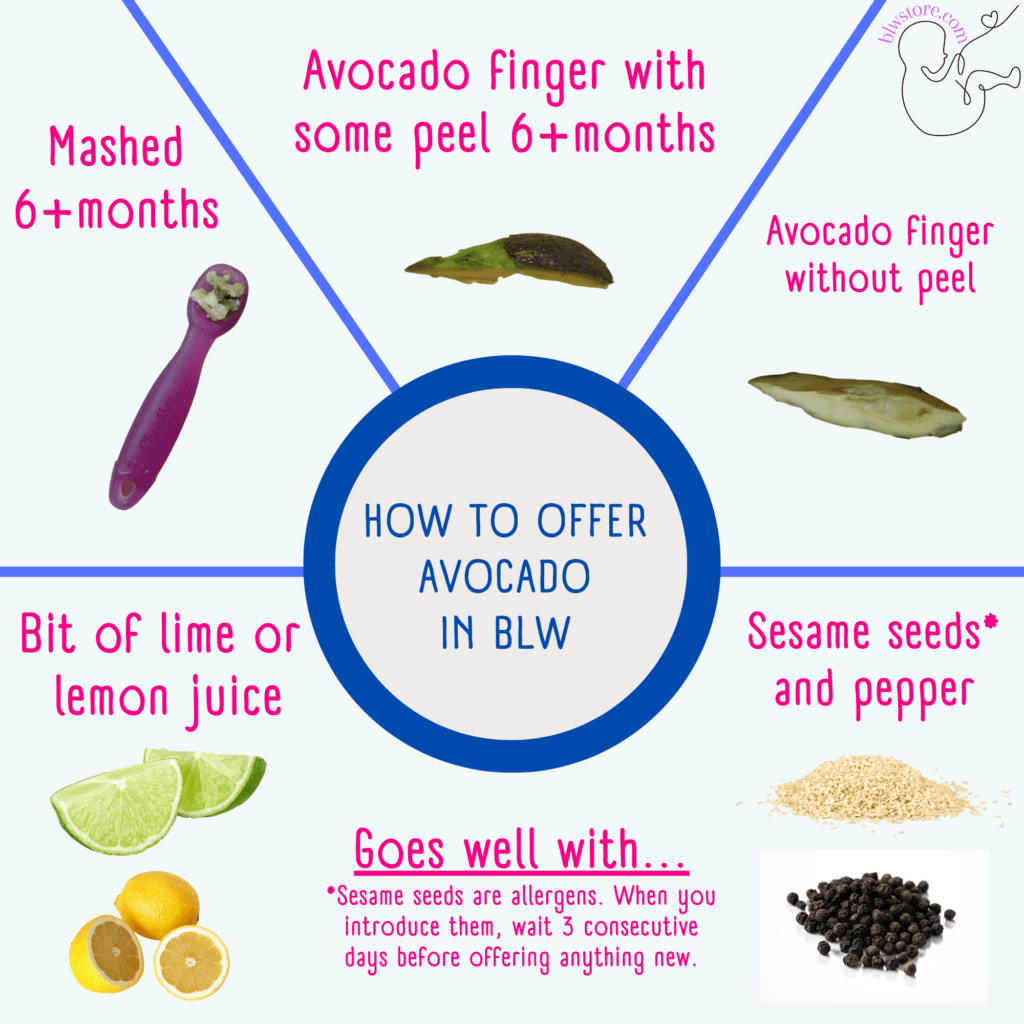
| “How Do You Serve Avocado In Baby-Led Weaning?” |
|---|
| First introduce avocado in its natural form. |
| Mashed avocado is perfect for utensil use and fine motor skill development. |
| Leaving a bit of peel on avocado fingers makes it easier for babies to grasp. |
| For 8+ months, serve avocado fingers with no peel. |
Apples (click to check our guide)
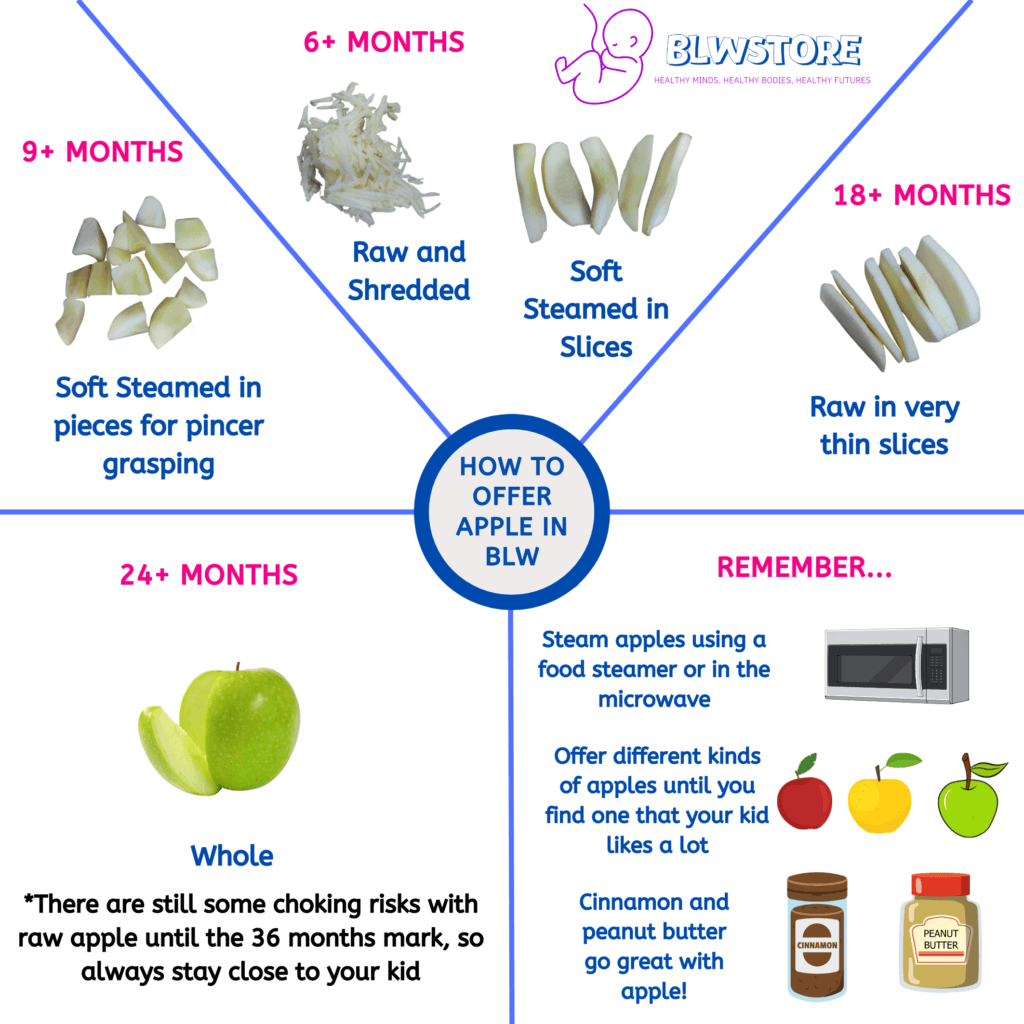
| Age Range | Serving Suggestions |
|---|---|
| 9-18 months | Offer sections of cooked apple and consider serving raw apple rounds, about one centimeter thick, with or without skin. Encourage chewing on the skin to develop grinding and oral-motor skills. |
| 18-24 months | Try offering whole apples, taking care to remove the core and seeds before serving. Peel the apple or peel it in “stripes” if the child struggles with the skin. |
| 24+ months | Offer sections of raw apples, such as a quarter piece. Be close to the child when offering it. Show them how to eat whole bites with skin while eating apples. |
Carrots (click to check our guide)
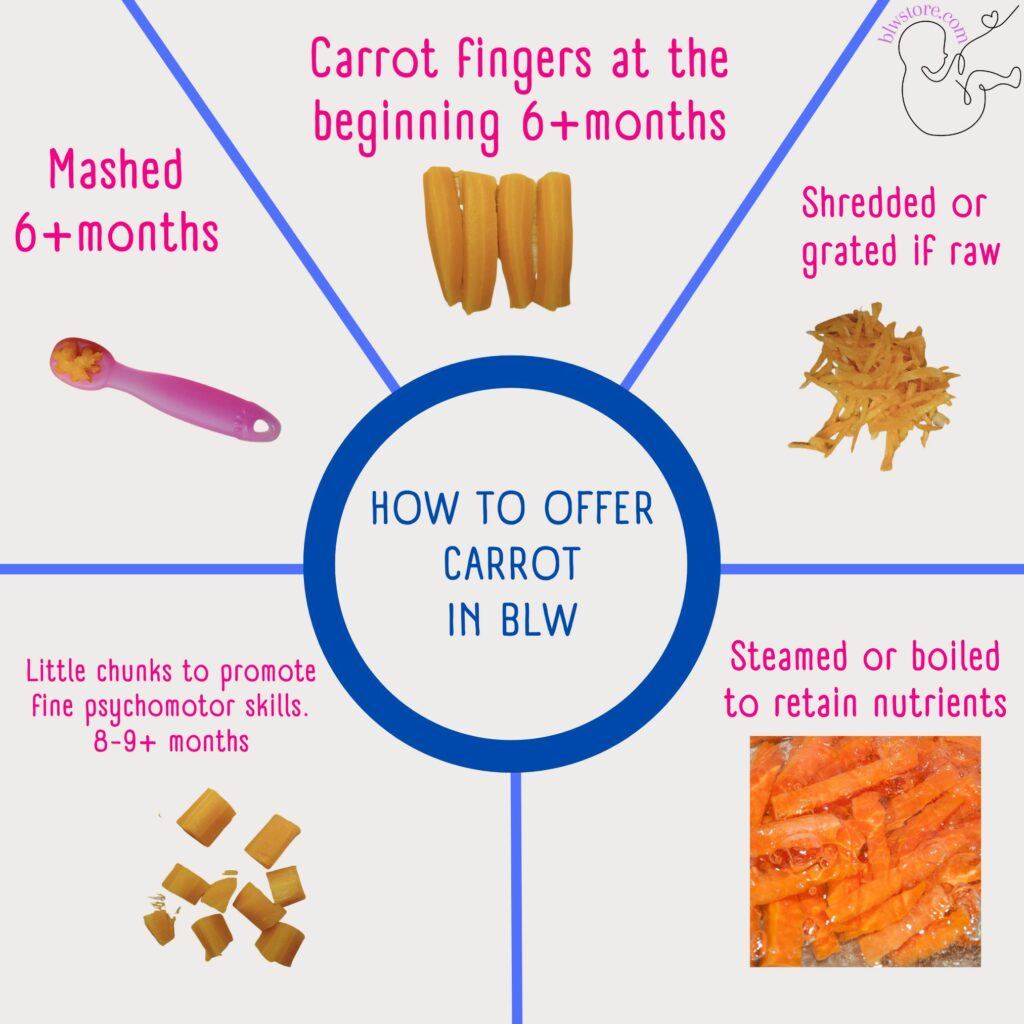
| Best Way to Serve Carrots |
|---|
| Carrot Fingers – peeled, steamed or boiled, tender texture, thick enough to grasp |
| 6+ Months: Carrot-fingers or whole (cooked), tender texture, right size for baby’s hand |
| Carrot Shredded (if raw) or Chunks (8, 9 months) – cooked at first, then can be mixed with other foods |
Pears (click to check our guide)
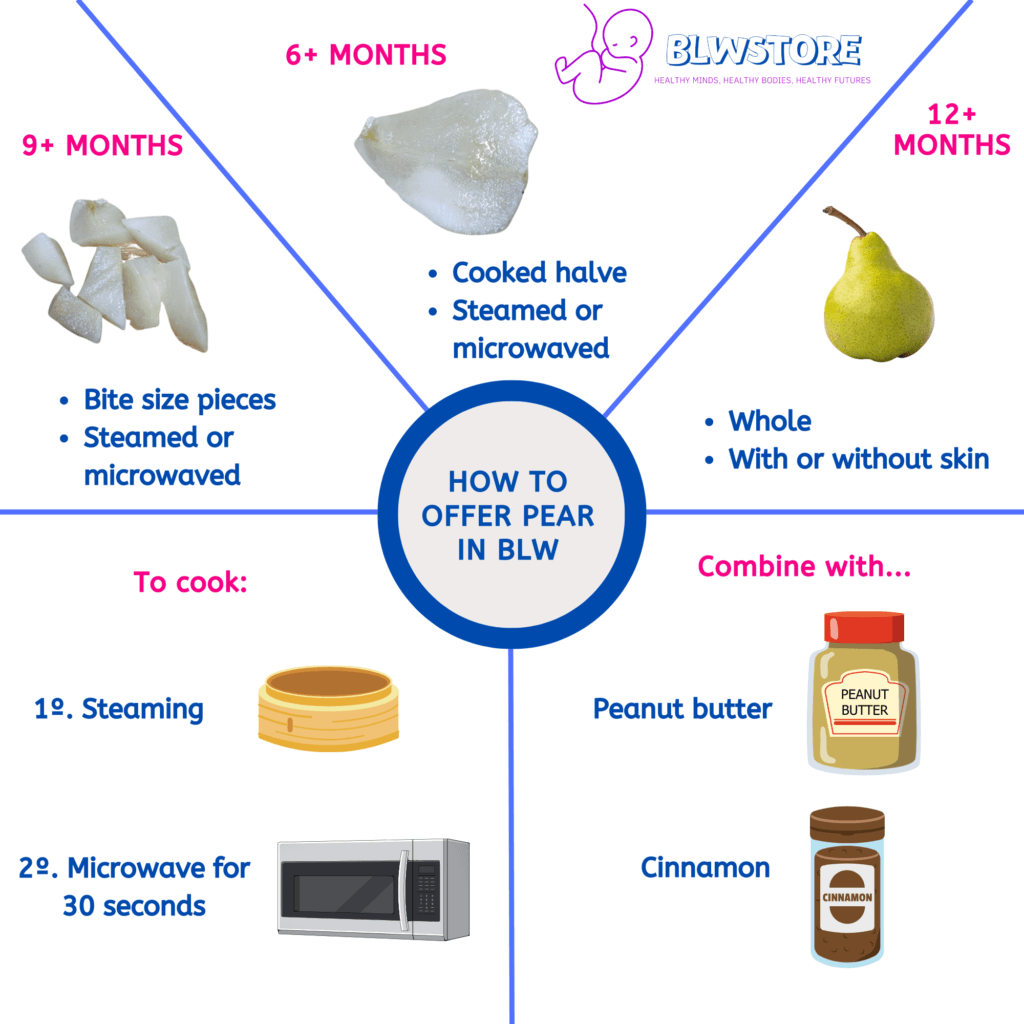
| Age | Serving Suggestions |
|---|---|
| 6-9 months | Cooked halves or mashed pear, consider removing skin |
| 9-12 months | Bite-sized pieces of steamed or microwaved pear |
| 12+ months | Whole pear with or without skin, mix with other fruits and flavors, add spices or nut butter |
Peaches or mango. (click to check our guide)
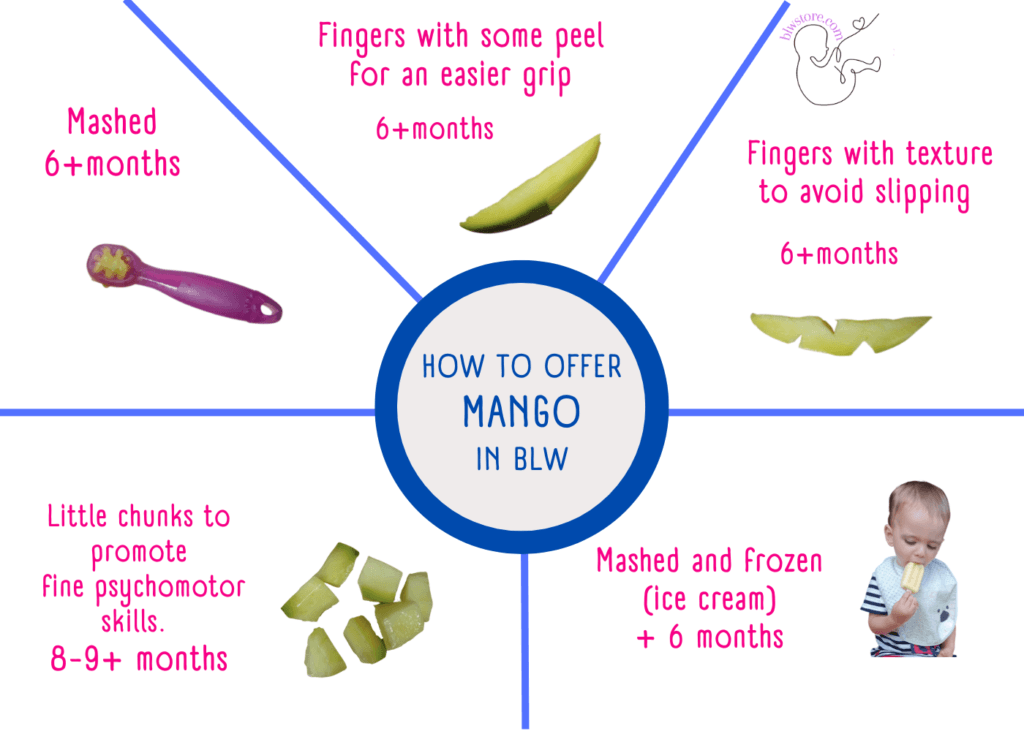
| Age Range | Serving Suggestions |
|---|---|
| 6-9 Months Old | Mango pit peeled, with most of the flesh removed. Mango cut into lengthwise spears and served with shredded coconut. |
| 9-12 Months Old | Bite-sized pieces of mango as a finger food or on a pre-loaded fork. Mince the mango and serve it atop scoopable foods like yogurt or ricotta. |
| 12+ Months Old | Larger pieces of fruit. Combine mango with other foods. |
Bananas (click to check our guide)
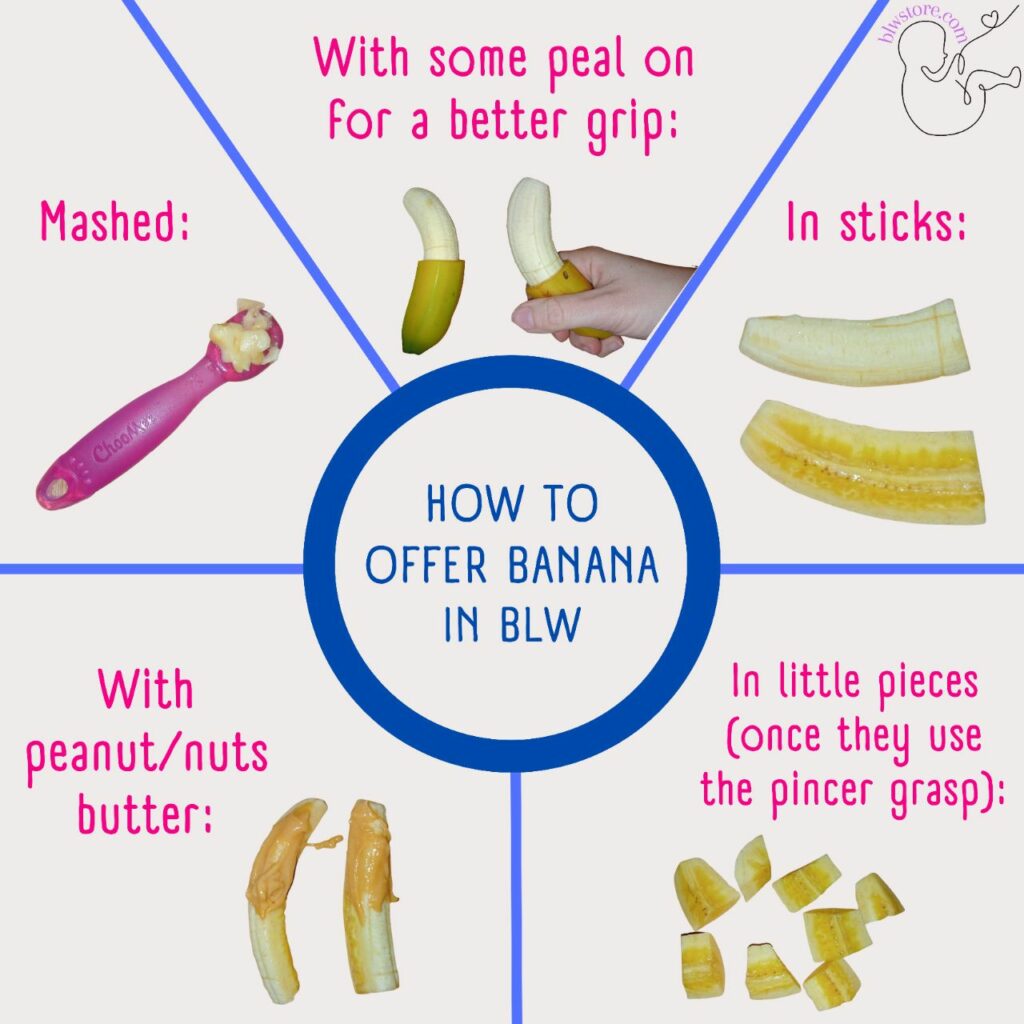
| Age Range | Serving Method |
|---|---|
| 6-9 Months Old | Banana Fingers |
| Banana Half Peel | |
| Mashed Banana | |
| 9-12 Months Old | Banana In Little Pieces |
| Mashed Banana | |
| Half Banana With Some Peel | |
| Peanut Or Almond Butter And Banana | |
| 12+ Months Old | Frozen Banana |
| Banana In Little Pieces | |
| Peanut Or Almond Butter And Banana |
Sweet Potatoes (click to check our guide)
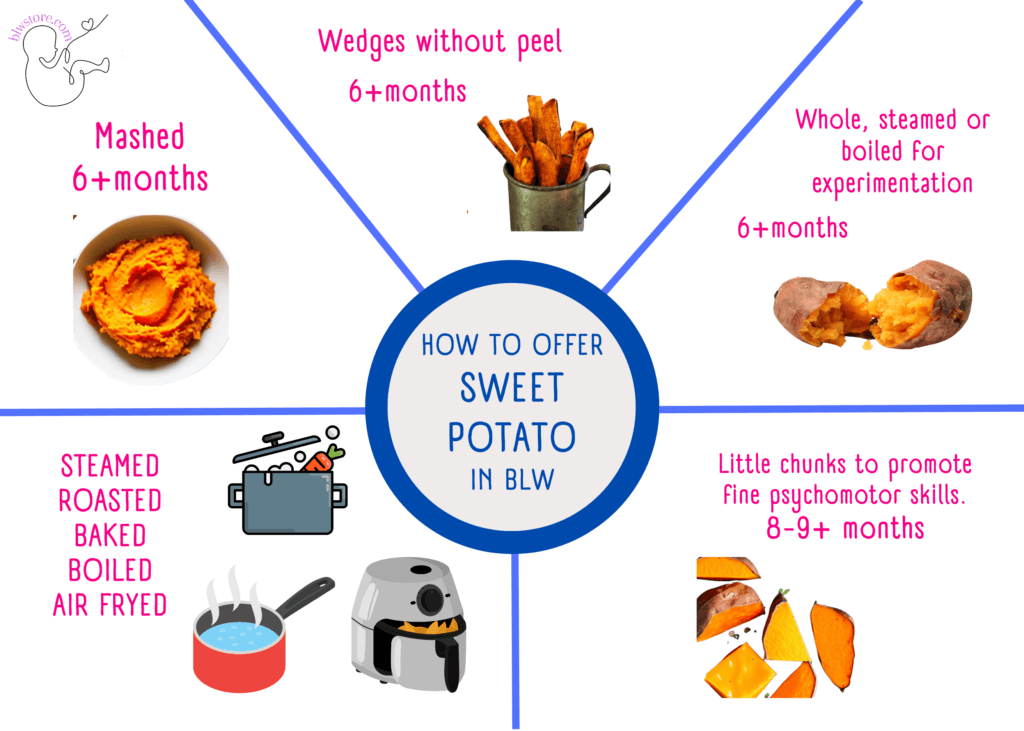
| Age | Method | Description |
|---|---|---|
| Starting solids | Mashed | Cook and peel the sweet potato, then mash it with milk, formula or water to desired texture. |
| 6+ months | Puree | Cook and peel the sweet potato, then blend it until it reaches a smooth consistency. Can add spices like curry or paprika. |
| Finger foods | Wedges | Bake or roast sweet potato wedges until soft enough for baby to grab and eat. A nutritious alternative to traditional baby snacks. |
Broccoli (click to check our guide on broccoli)
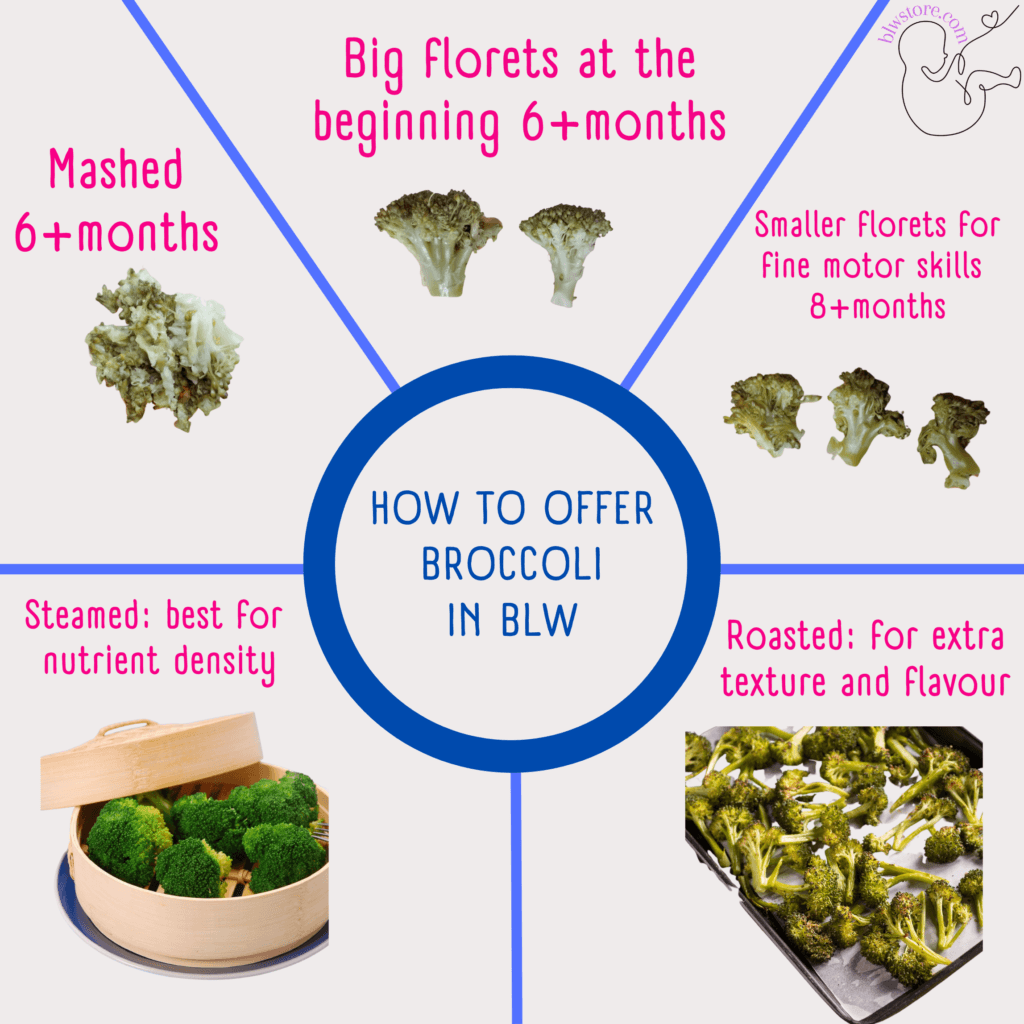
| Method | Age | Description |
|---|---|---|
| Big Florets. Steamed or Roasted. | 6+ months | Steam or roast large broccoli florets to introduce broccoli to your baby. If your baby rejects it, try adding some spices or roasting to make it crunchy. |
| Mashed. Steamed or Roasted | Any | Mash steamed or roasted broccoli for a different texture and to mix with other foods. |
| Small Florets | 8+ months | Cut small broccoli florets to promote fine motor skills development once your baby can pincer grasp. |
Strawberries (click to check our guide on strawberries)
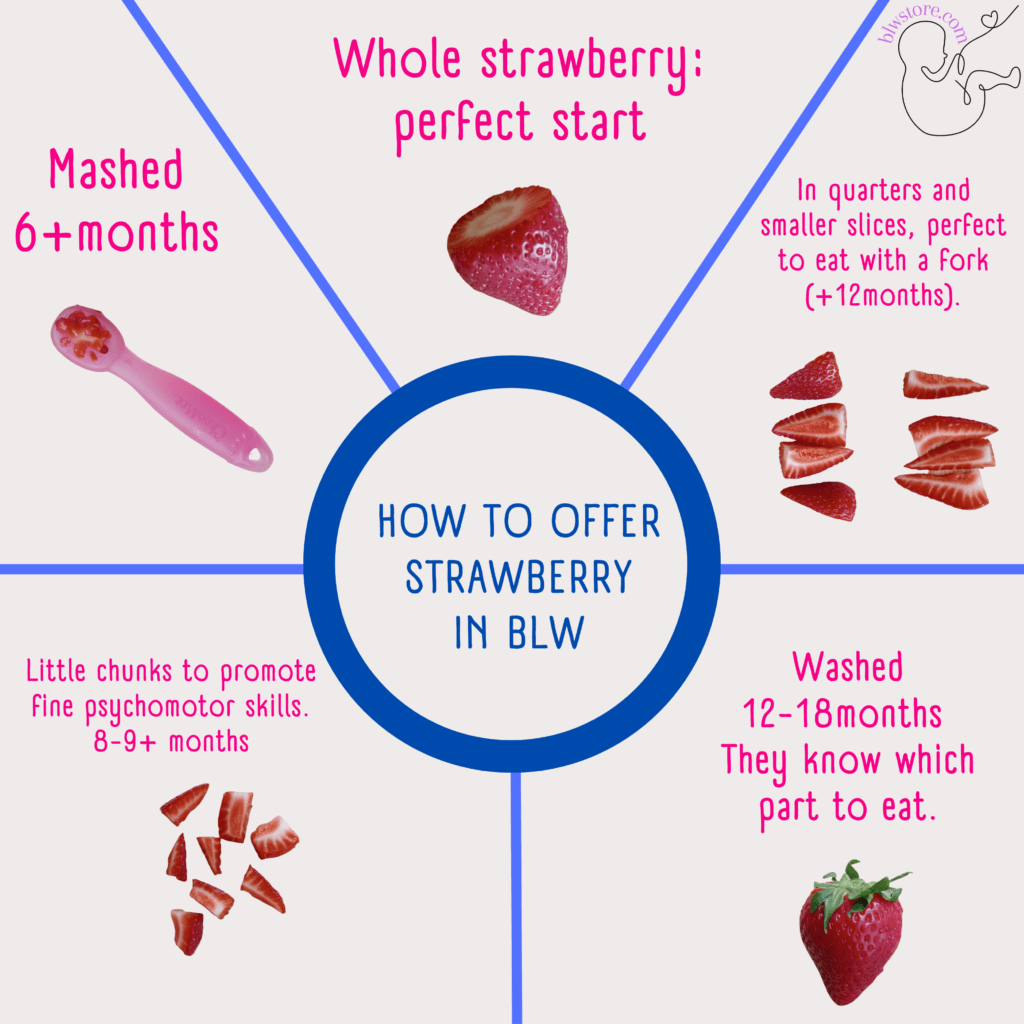
| Age Group | Serving Options |
|---|---|
| 6+ Months | Whole Strawberry, Mashed Strawberry |
| 8 or 9+ Months | Little Chunks of Strawberry |
| 12+ Months | Strawberry Quarters for Fork Use |
Oranges (click to check our guide on oranges)
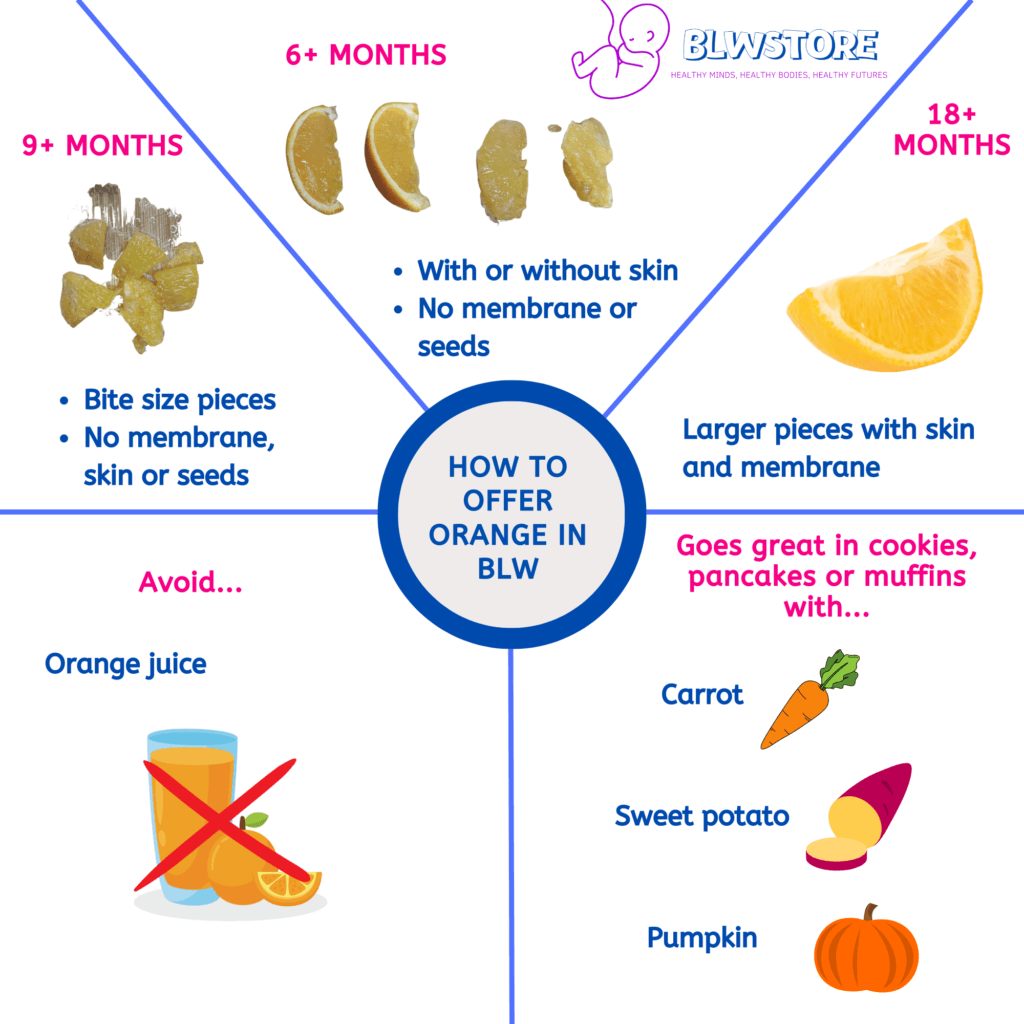
| Age | Serving Suggestions |
|---|---|
| 6 to 9 months | Orange wedges with skin removed or kept on, and seeds and membrane removed |
| 9 to 18 months | Bite-sized pieces of orange without skin, with seeds and membrane removed |
| 18 to 24 months | Large pieces of orange with membrane intact, bite-sized pieces, or wedges with skin on or off |
Kiwis (click to check our guide on kiwis)
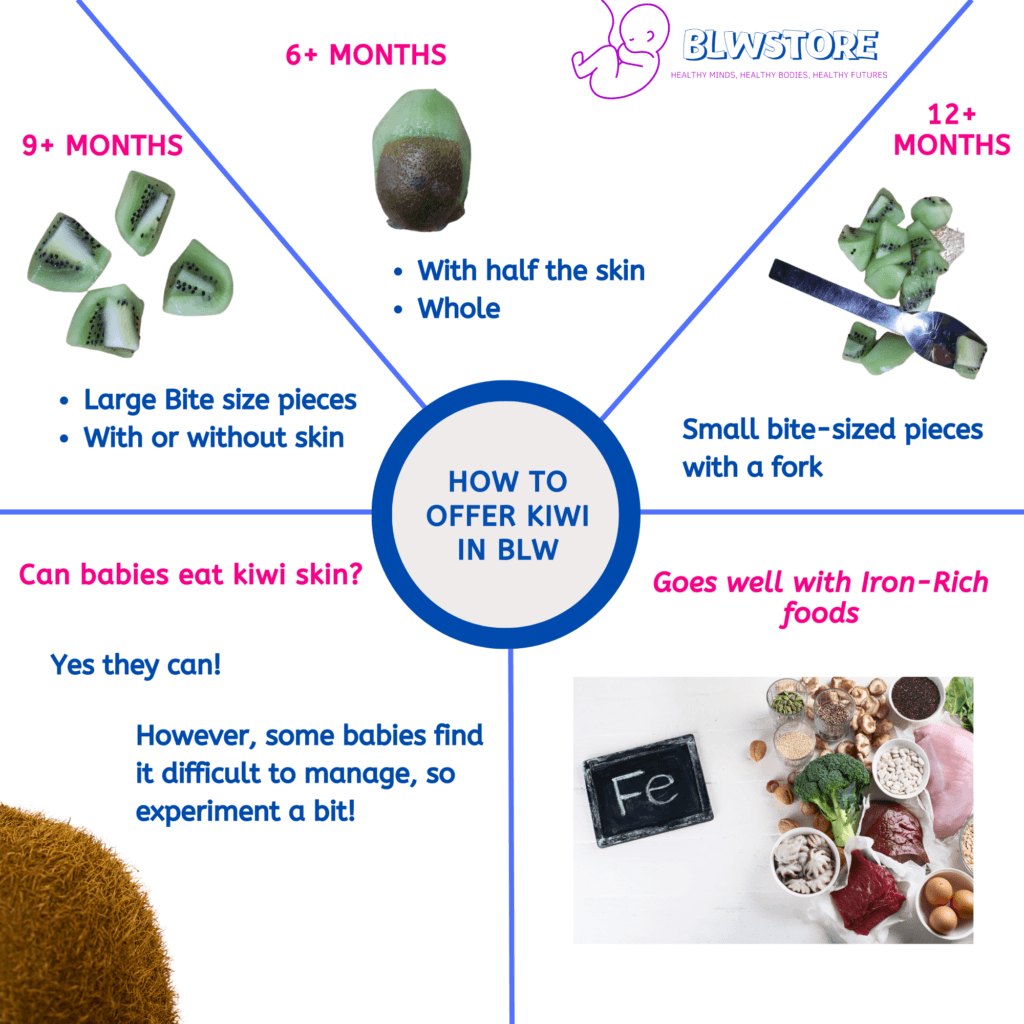
| Age | Serving Suggestions |
|---|---|
| 6 to 9 months | Peeled or unpeeled ripe whole kiwis, or a ripe kiwi half. Mash and mix it with other fruits or oatmeal. |
| 9 to 12 months | Chopped kiwi, with skin on or off. Roll slippery pieces in finely ground food. |
| 12+ months | Bite-sized pieces of ripe, peeled, or unpeeled kiwi as finger food or served with a fork. Use it as a sweet topping for other foods. |
Corn (click to check our guide on corn)
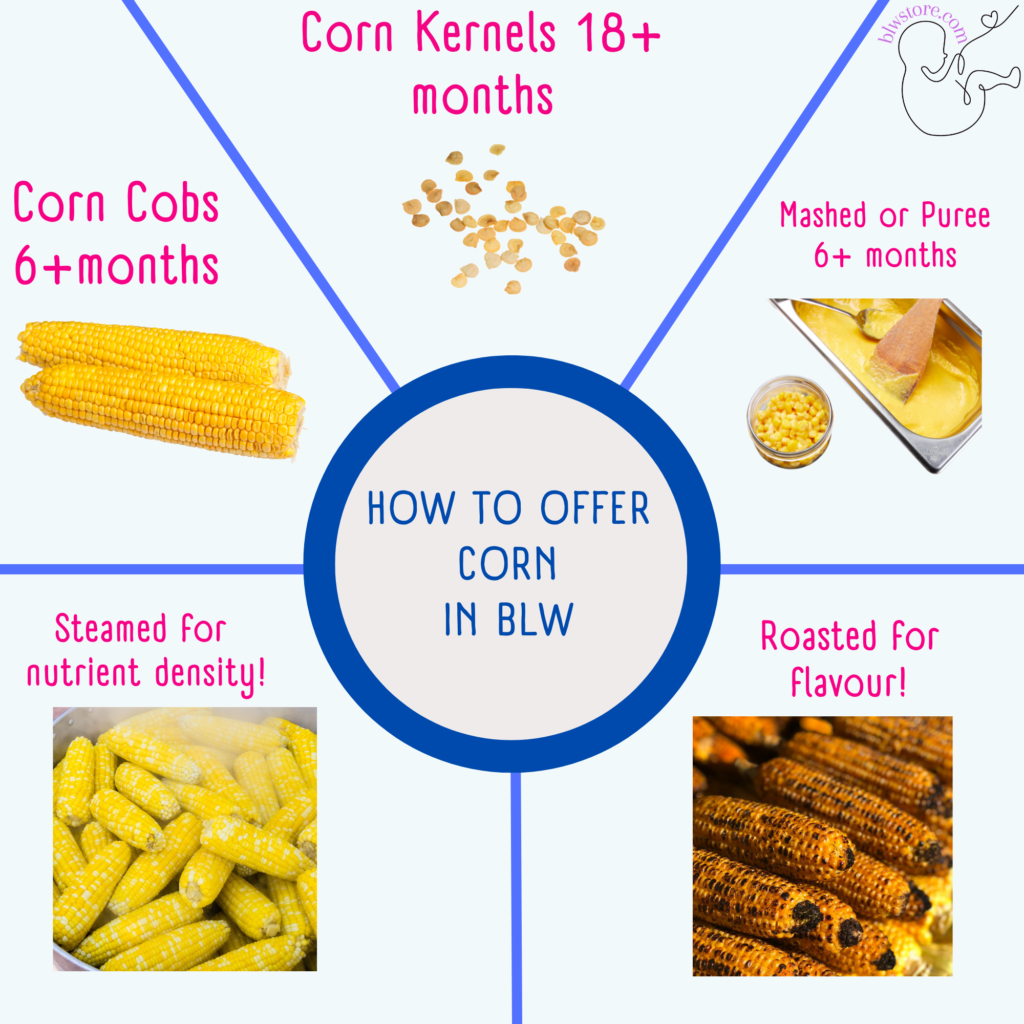
| Age Range | Serving Suggestions |
|---|---|
| 6+ months | Steamed, roasted or pan-fried corn cobs, cut into manageable sections |
| 18+ months | Introduce corn kernels as a new food option, and monitor your child closely during mealtime |
| All ages | Mash cooked corn if you don’t want to serve it on the cob |
Cauliflower (click to check our guide)
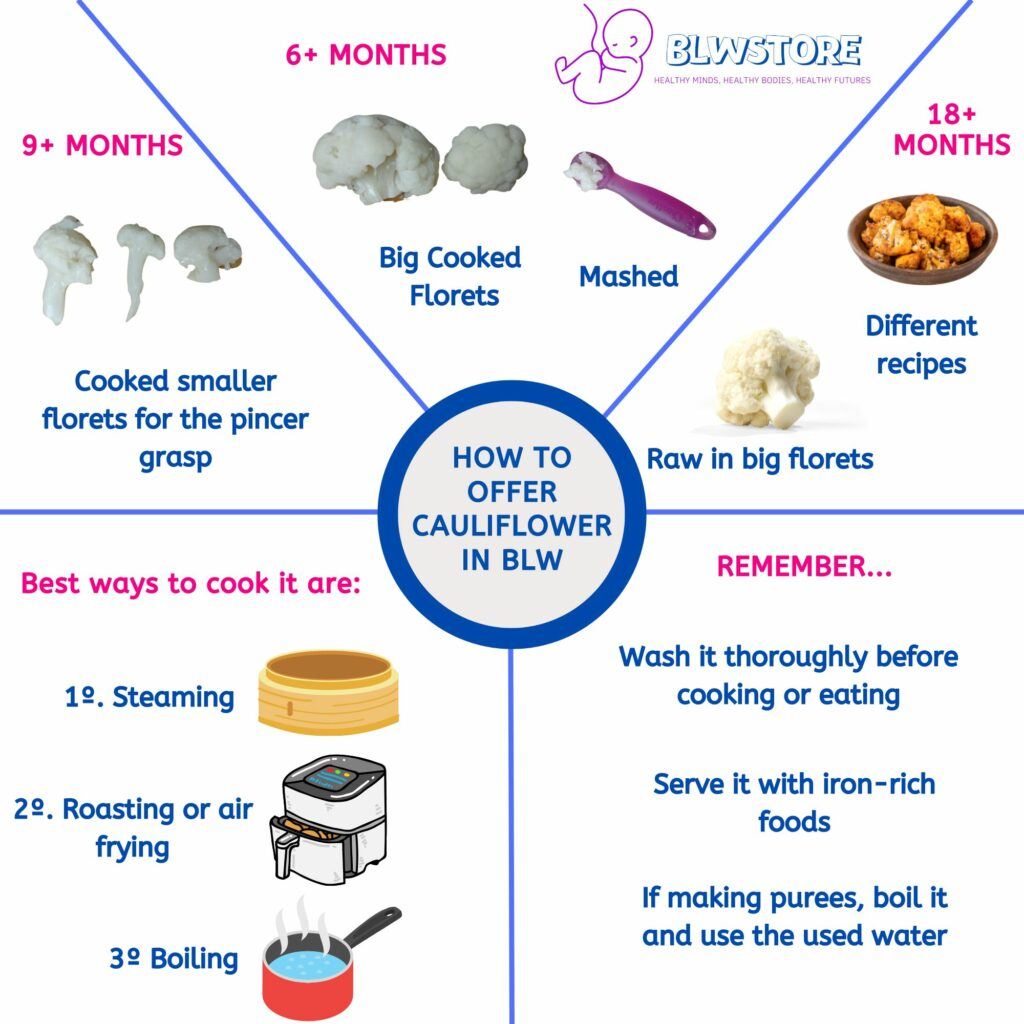
| Age Range | Serving Suggestions |
|---|---|
| 6-9 Months | Large florets of soft cooked cauliflower cut in half vertically or mashed cauliflower |
| 9-18 Months | Smaller bite-sized pieces of cooked cauliflower florets, with larger florets for gnawing |
| 18+ Months | Cooked cauliflower florets on their own, as part of shared meals, or pre-loaded on utensils to encourage use of forks or spoons. Decrease cooking time as they approach 24 months. |
Zucchinis (click to check our guide)
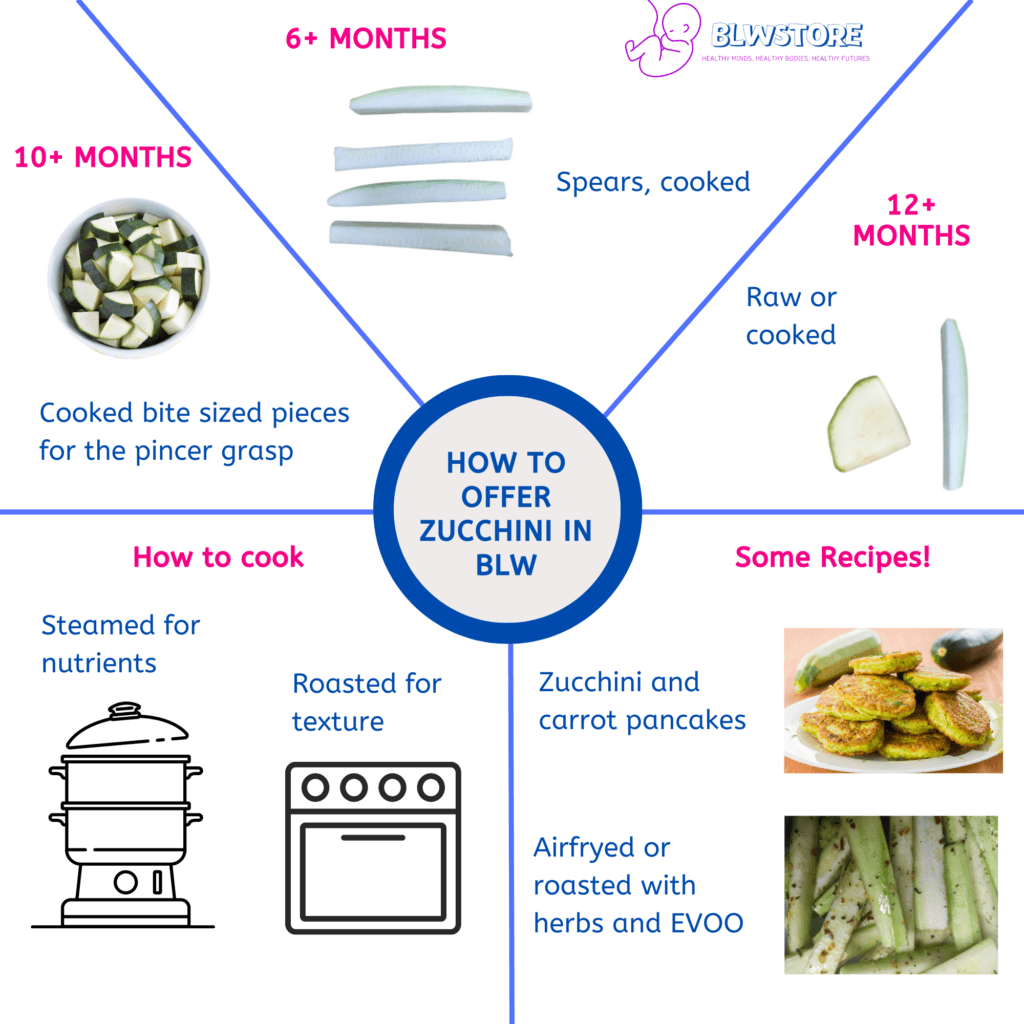
| Age Range | How to Serve | How to Cook | Additional Flavors |
|---|---|---|---|
| 6+ months | Fingers or mashed | Steamed or Roasted | Oregano, thyme or rosemary, touch of pepper |
| 9-12 months | Softened chunks or spears | Steamed or Roasted | Garlic powder or small amounts of fresh cheese |
| 12+ months | Diced or sliced | Steamed or Roasted | Lemon juice, paprika, or small amounts of grated Parmesan cheese |
Best grains and legumes
Grains and legumes are high in fiber and provide a source of carbohydrates and proteins. They are also a great source of vitamins and minerals.
Here are the best grains and legumes for baby-led weaning:
Oats (click to check our guide on Overnight Oats)
- When: 6+ months
- How: Overnight Oats (watch video)
- With: Vegetable milk, formula or breast milk. Ceylon cinnamon and fruit.
White Rice (click to check our guide)
- When: 6+ months
- How: Cooked until soft (watch video)
- With: Any other vegetable already introduced
Lentils
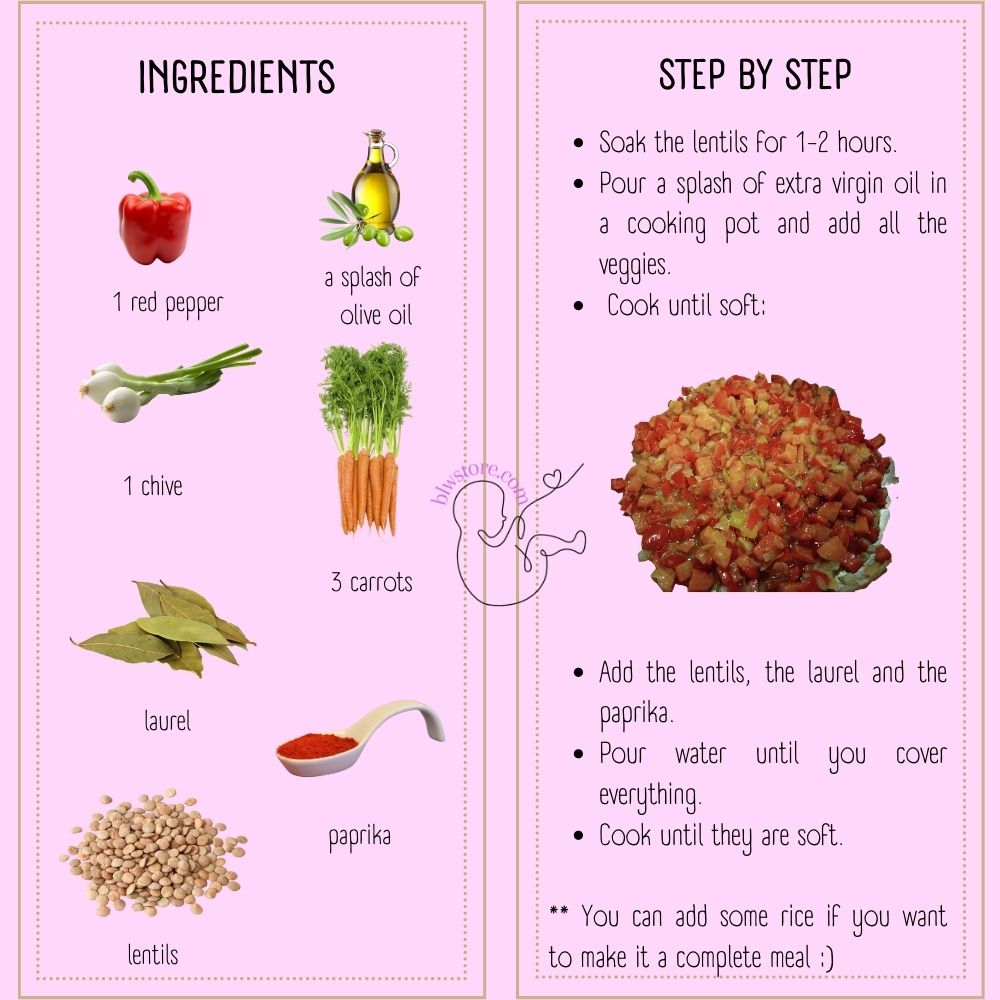
- When: 6+ months
- How: Cooked until soft or mashed (see recipe)
- With: Any other vegetable already introduced
Chickpeas
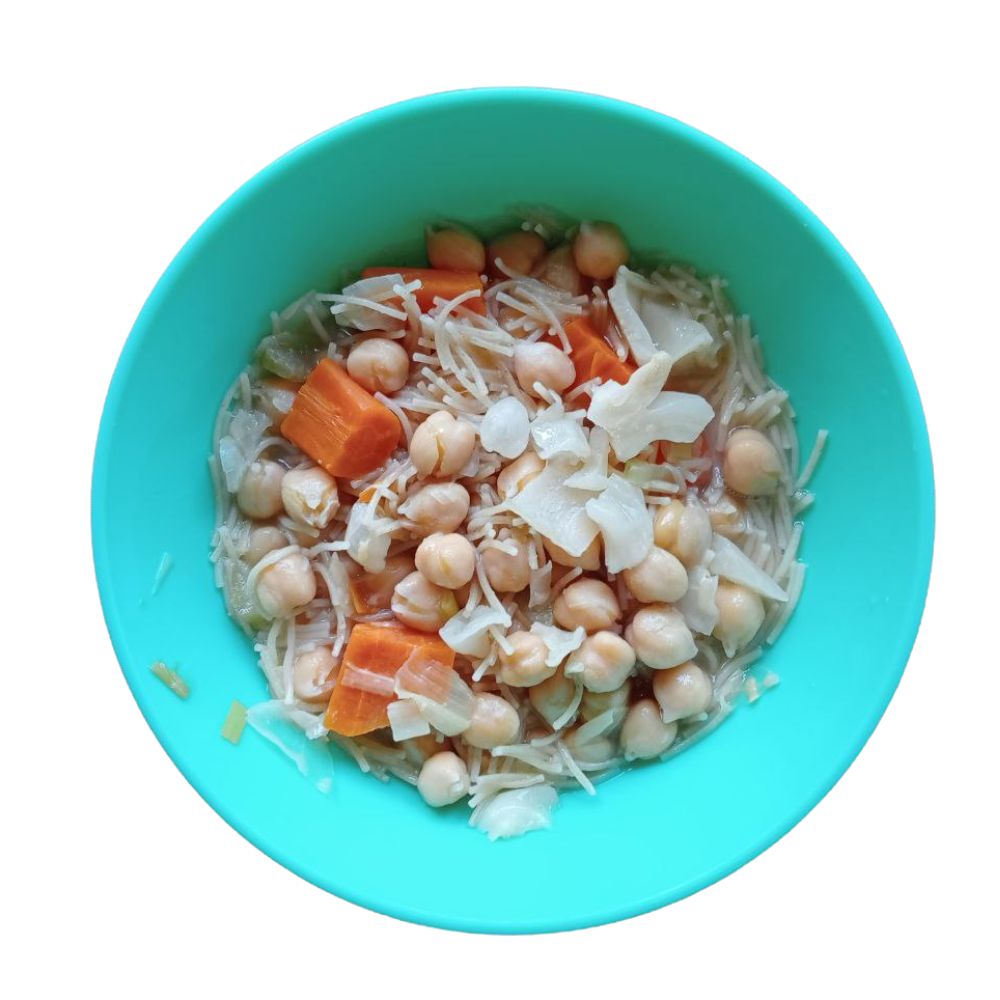
- When: 6+ months if crushed a bit
- How: Cooked until soft, also in puree.
- With: Any other vegetable already introduced
Green beans
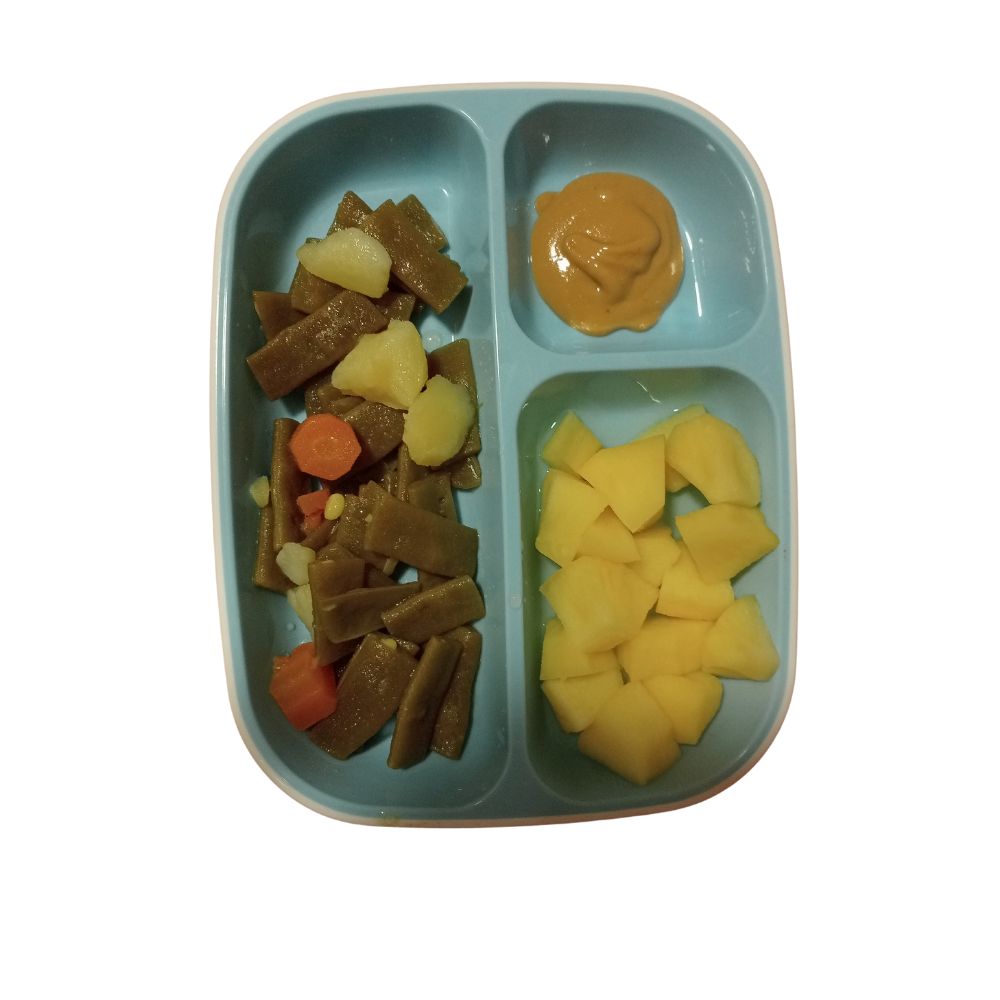
- When: 6+ months
- How: Steamed and sauteéd (both)
- With: Any other vegetable already introduced. We love them with carrots and potatoes
Best dairy products
Protein, calcium, and other necessary vitamins and minerals can all be found in dairy products. (Related read: How to Structure your Baby’s and Toddler’s Meals)
The introduction of cow’s or goat’s milk to infants shouldn’t begin until they are at least one year old; it is crucial to remember this.
You can give your kid dairy items throughout the first year, but only in very modest amounts, including yogurt, cheese, and kefir. Furthermore, not all cheeses qualify.
Make sure to buy organic, full-fat dairy products without added sugars when introducing dairy to your infant.
We have a detailed page about yogurt and dairy products if you’re interested.
Some of the top dairy items for baby-led weaning include:
Plain, full-fat yogurt
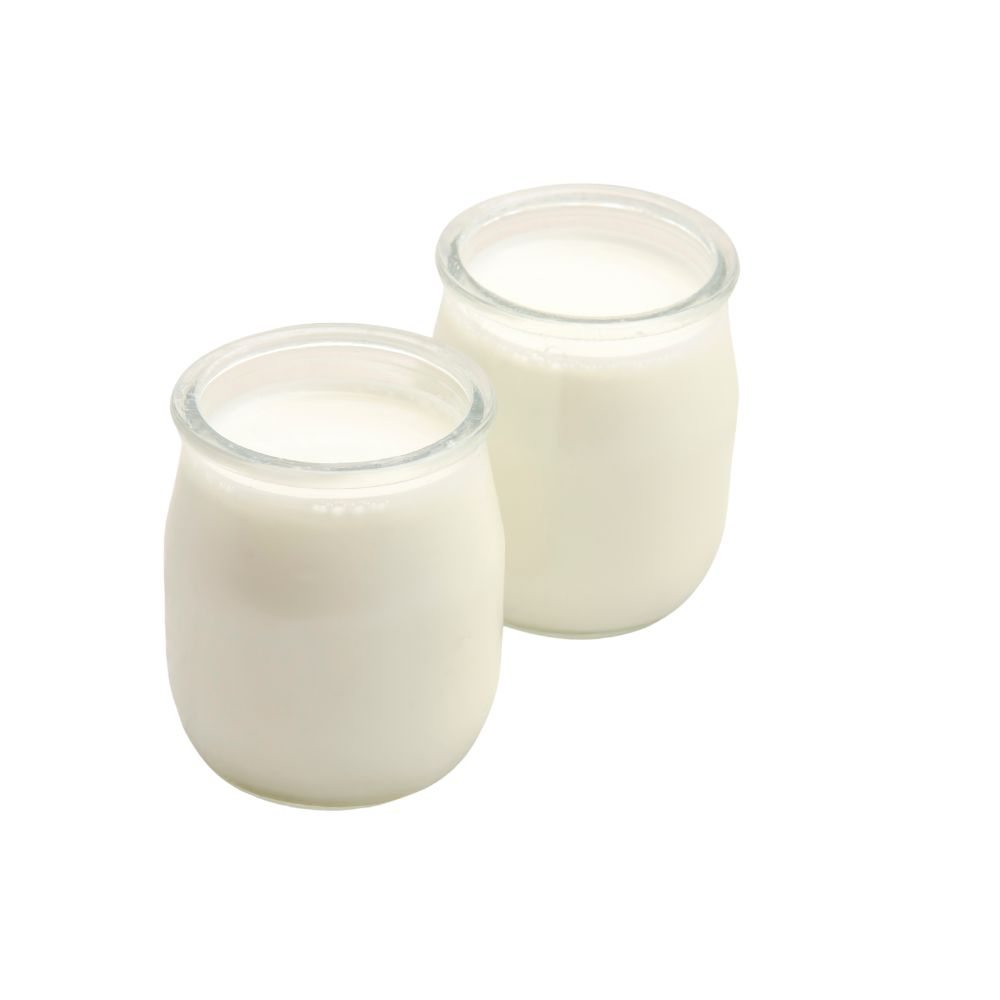
- When: 9+ months
- How much: 2-3 teaspoons a day
- With: Ceylon cinnamon, puffed spelt, any fruit…
Plain, full-fat kefir
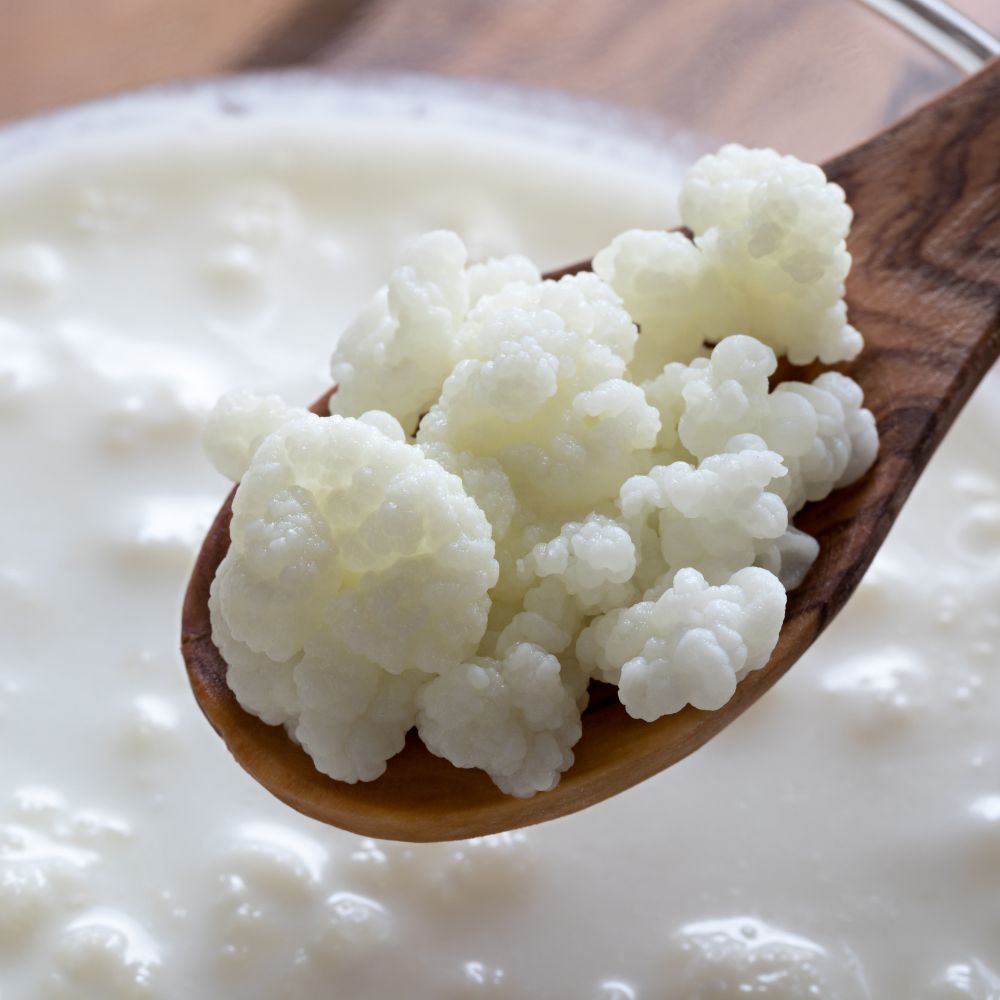
- When: 9+ months
- How much: 2-3 teaspoons a day
- With: Ceylon cinnamon, puffed spelt, any fruit…
Which cheese is best for babies?
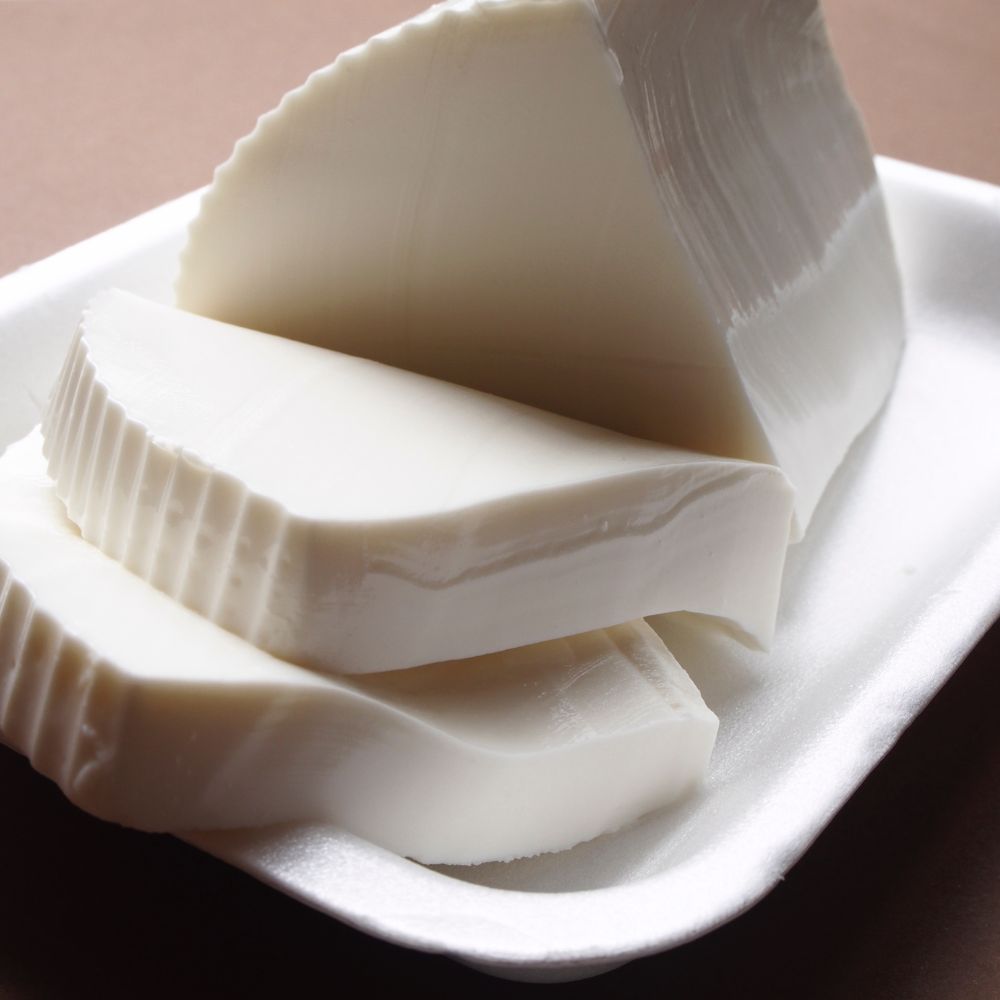
Fresh Cheese is the best option for babies. Low salt content always. Check out our guide on the Best Cheese for Blw.
- When: Best 12+months
- How much: 500 ml is the max amount of dairy between 1-3 years of age
- With: On whole grain bread, with fruit…
Best protein sources
Any baby’s diet should contain enough protein. They offer the essential amino acids required for development and growth.
When giving proteins to your kid, be sure to thoroughly cook them and stay away from salt and sugar additions.
Always try to provide goods from animals raised on organic, free-range farms. We can begin introducing tiny amounts of animal protein at the age of six months.
*Read: Chicken Nuggets Recipe for BLW | Baby-Led Weaning: Bacon
It is recommended to start by only cooking with a tiny bit of olive oil. Spices don’t need to be added because your baby will become used to the flavor on its own.
We should exercise caution when supplying too much protein, too. Here is a table showing the suggested dosages:
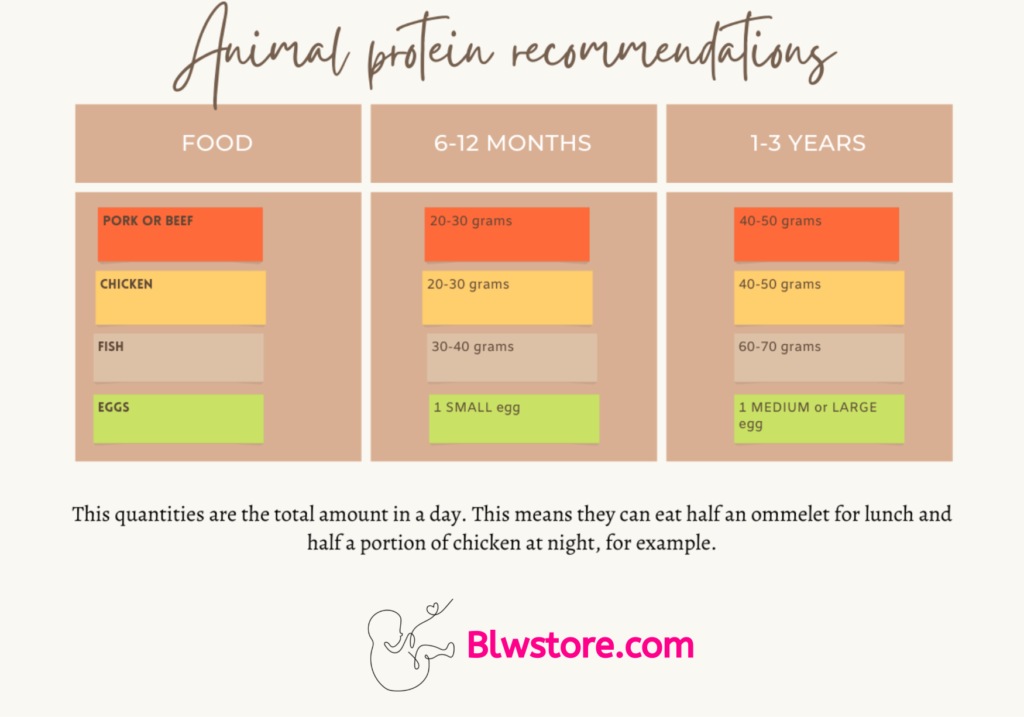
What is the best way to cook for Babies?
When cooking food for your baby, make sure to avoid adding salt, sugar, and other seasonings at first.
With time you can start adding some seasonings without sugar or salt.
Best one: Steaming
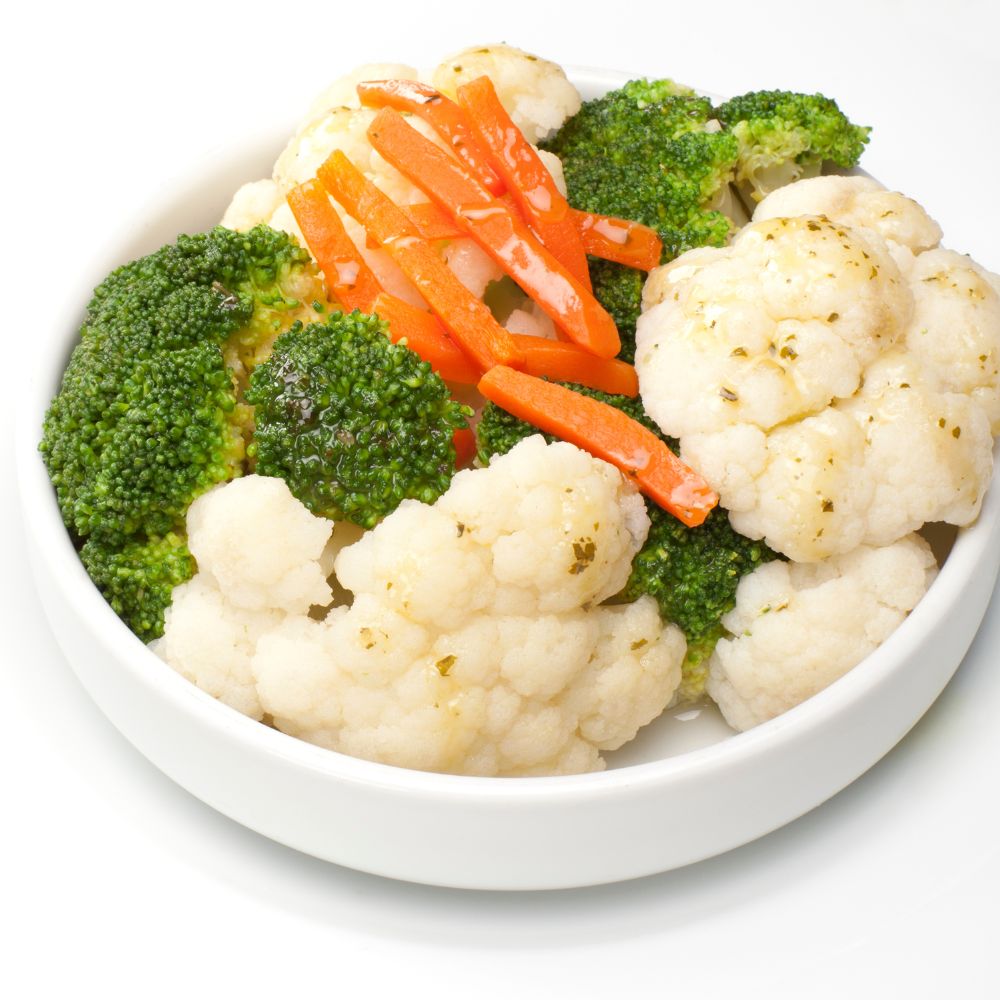
Steaming is one of the most common ways to prepare BLW because of the many benefits it provides.
- First, steaming aids in retaining the food’s flavor, texture, and nutritional value.
- Food can be ready in a fraction of the time it would take to boil or bake because to the steam’s consistent and rapid heating.
- Steaming is a healthier alternative to frying or sautéing because it uses so little oil or fat.
- Keeping food’s original color and shape is another benefit, which can make it more visually appealing.
- Finally, steaming is a fantastic method for cooking a variety of foods simultaneously since the steam can move freely around the meal, ensuring that everything is cooked to perfection.
Overall, steaming is the healthiest and most time-saving method of cooking food, allowing you to make delicious meals with little to no work.
Second Best: Roasting
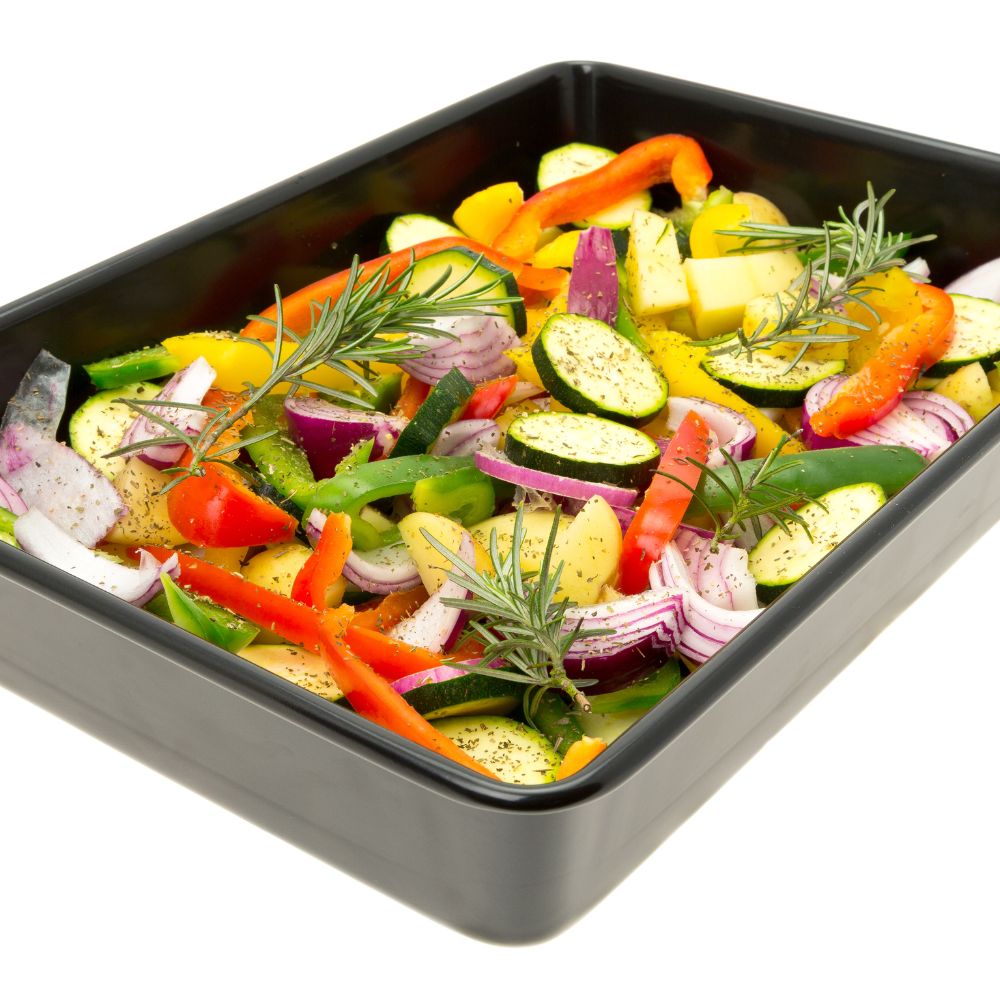
Roasting is one of the greatest cooking methods for baby-led weaning due to its numerous advantages over other methods.
- Through the caramelization of natural sugars and the Maillard Reaction, roasting aids in flavor retention and the development of nuanced, rich flavors.
- Moreover, roasting gives soft, juicy outcomes with a golden, crisp outside. This cooking technique is excellent for browning and crisping foods while retaining their moisture.
- Roasting can also be used to rapidly prepare huge quantities of vegetables and meat cuts.
- Roasting is also an extremely hands-off method of cooking, making it ideal for busy home cooks who want to prepare delectable dishes without continually monitoring the food.
- Due to the fact that most foods can be roasted in a single pan, roasting has the extra benefit of minimum cleanup.
What are some Tips for Introducing New Foods in BLW?
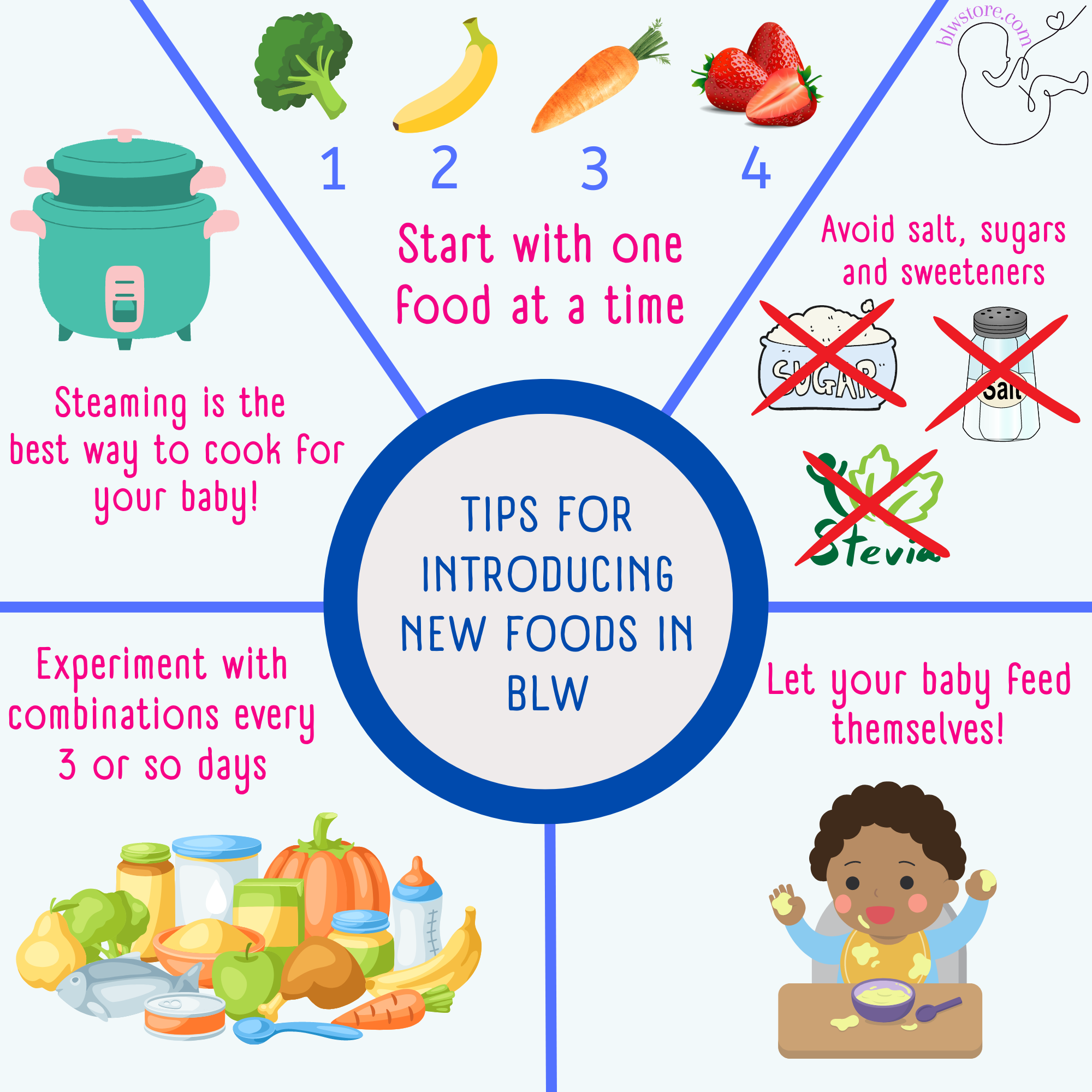
Introducing new foods to your baby can be a daunting task. It is important to be patient and let your baby explore different flavors and textures at their own pace. We have an article solely on introducing solids if you are interested in learning more.
Here are some tips to help you introduce new foods to your baby:
1. Start with one food at a time
Always start with one food at a time.
If it is not allergenic, you should offer that food for 1 day and the next day you can offer another.
If it is allergenic, you should wait 3 days before introducing another.
Here is a list of the most common allergens:
- Cow’s milk
- Eggs
- Soy
- Peanuts
- Tree Nuts
- Wheat
- Fish (salmon is perfect to introduce first)
- Shellfish
2. Avoid adding salt, sugar or sweeteners
To your baby’s food, never add salt, sugar, or sweeteners.
Your baby will enjoy it even if it appears bland to you because his taste senses are still developing.
For as long as you can, you should strive to prevent your newborn from tasting meals that contain these ingredients. Once they do, turning around is quite challenging.
3. Increase the variety over time
Start slowly and add more variety to your plate over time.
It is not necessary to give combination dishes from the beginning, in fact it is not recommended.
Introduce one food at a time and when he has tried 20-30, start combining them.
4. Let your baby feed themselves as much as possible
Try to make your baby as autonomous as possible.
Instead of putting food in your baby’s mouth, unless it is a puree, let your baby do it by imitation.
Stand in front of your baby and make eye contact. When your baby looks at the food, pick it up with your hand and bring it to your mouth. Then offer it to them by placing it in front.
Tips and tricks while doing Baby-Led Weaning
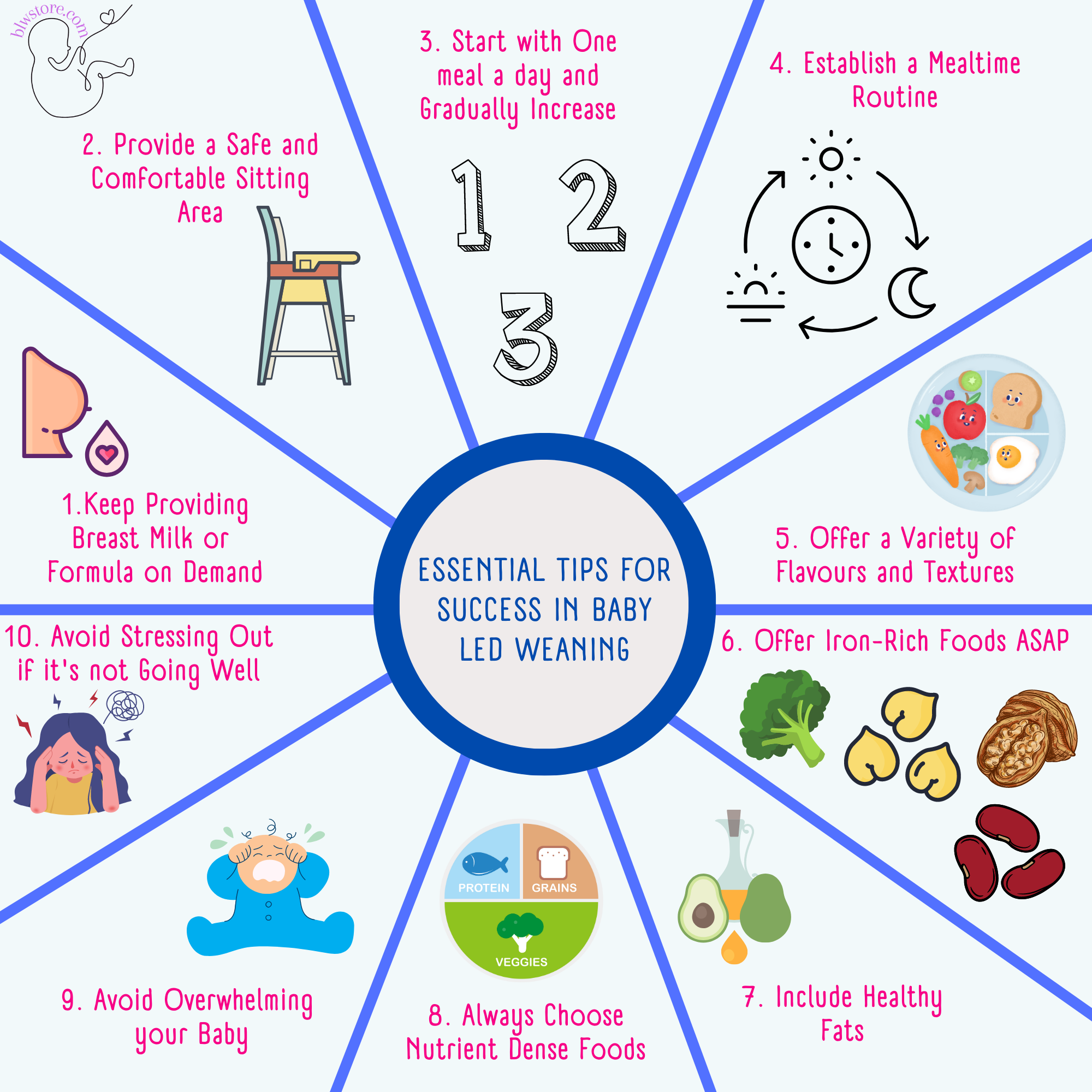
Creating a balanced and nutritious meal plan for your baby can seem complicated. If you want more information on how to structure meals, we have a full article explaining it.
However, it doesn’t have to be if you know the basics. Here are some tips to help you create a balanced meal plan for baby-led weaning:
1. Keep providing breast milk or formula on demand
Until 12 months of age, breast milk or formula will continue to be the main source of nutrients for your baby.
That is why Baby-Led Weaning or Purees are called Complementary Feeding.
2. Provide a safe and comfortable sitting area
Your baby’s meal area is crucial.
If they’re not napping, having your infant sit near to you during meals is better.
Success requires a comfy place with a good high chair.
3. Start with one meal a day and gradually increase
Even if your baby sits with you during breakfast, lunch and dinner, you have to start slowly.
Start with breakfast or lunch and as the days go by begin to establish a routine of offering food whenever you eat.
4. Establish a mealtime routine
Establishing routines is one of the most important aspects for a baby and for children in general. This is true at all levels and meals are no exception.
Having a more or less strict schedule for offering solid foods to your baby is fundamental for them to start making relationships and brain connections and establish a healthy relationship with food.
It is also important to have a calm and positive environment during mealtime.
5. Offer a variety of flavours and textures
Once your baby has already tried several foods, try combining different tastes and textures in divided baby dishes.
This way your baby can begin to select and make small choices that will help them establish autonomy. (See: breakfast ideas for toddlers and lunch ideas for toddlers)
6. Offer iron-rich foods when possible
Since iron requirements are higher after 6 months of age, it is advisable to give foods with a higher iron content.
Learn more about nutrition here.
7. Include healthy fats
Don’t forget to include extra virgin olive oil, avocados, nuts and healthy fats in general.
Fats help the absorption of nutrients during digestion and are very important for cognitive development.
8. Always choose nutrient dense foods
Giving foods with a higher iron content is advised because iron requirements increase after the age of six months.
Find out more about nutrition right here.
9. Avoid overwhelming your baby
If you notice that your baby becomes overwhelmed, or stops paying attention to the food, just offer foods 1 by 1.
Eat in front of your baby, if possible the same food and they will surely start to imitate you. If you see that this doesn’t work after a few minutes, then your baby doesn’t feel like it and it’s better to do something else. There is plenty of time.
10. Avoid stressing out if it is not going well
You always have to try not to be overcome by stress. The atmosphere at the table has to be one of trust and tranquility.
Relaxing music can be helpful, but avoid other distractions such as toys, lights, etc.
If you start to get nervous about your baby throwing food, or not paying attention to you, don’t worry, just breathe and count to 10. If your baby is not interested, don’t force anything as it will only make things worse.
Whether it’s after a few days, weeks or even months, your baby will start eating solids, that’s for sure.
What are the essentials?
Certain baby-led weaning products are essential to help you and your baby do BLW more easily.
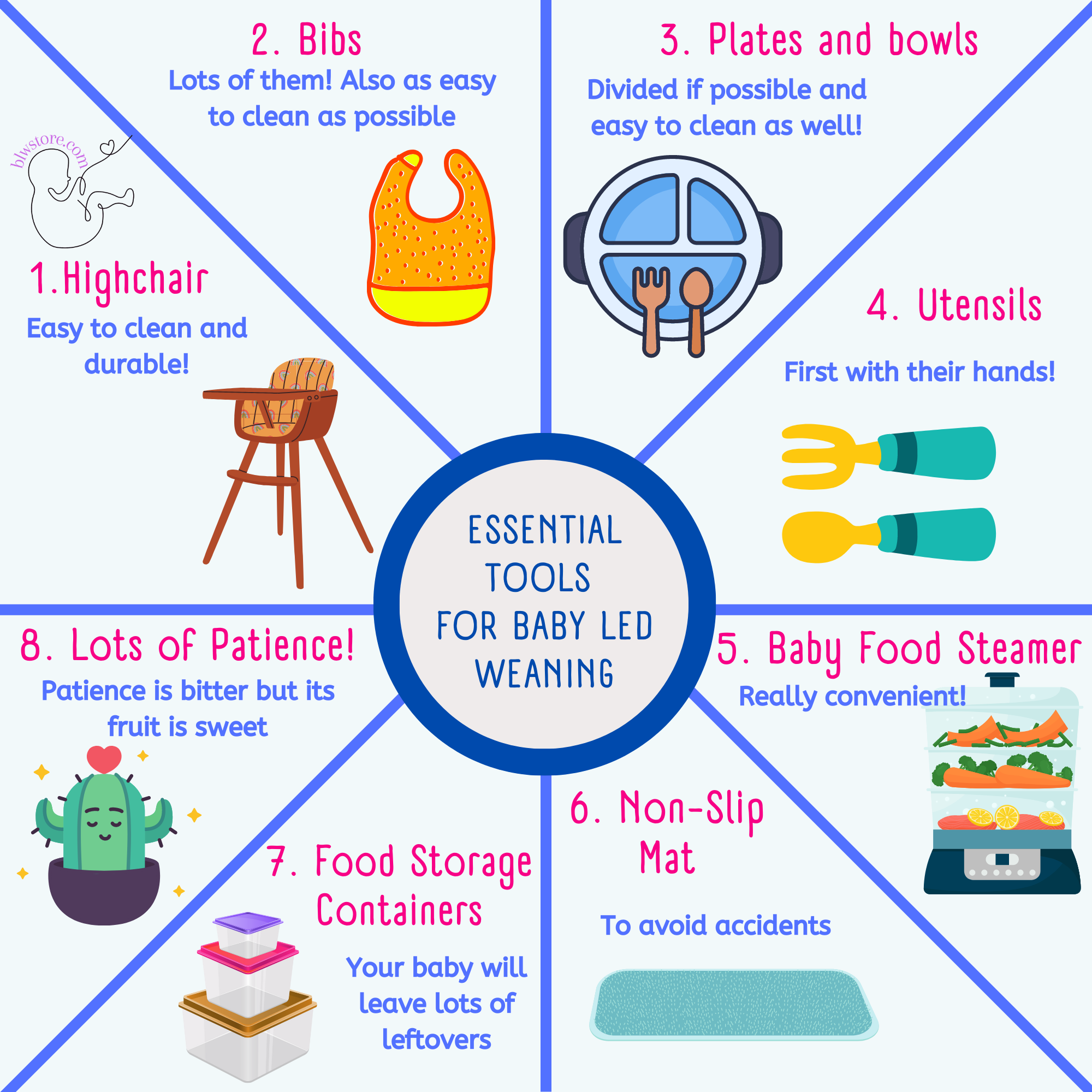
Conclusion
We hope you’ve enjoyed our Ultimate Guide to Baby-Led Weaning [BLW].
As you embark on the weaning baby-led approach around the six-month mark, creating a healthy meal plan for your baby is essential to their development. From fruits and vegetables to grains and legumes, and proteins, there are a variety of weaning foods that you can include in your baby’s meal plan.
This guide provides you with an essential baby-led weaning food and baby gear list that can help you create a balanced and nutritious meal plan for your little one and make mealtimes easier.
So, what are you waiting for? Get started on creating a healthy meal plan for your baby-led approach today!
Are you looking for more information on baby-led weaning meals? Check out our blog for more helpful tips and advice, like our post on 26 Easy and Delicious Breakfast Ideas and many others.
*It’s important to note that while baby-led weaning is a popular weaning approach, it may not be suitable for all babies. If you have any concerns or questions about baby-led weaning, it may be helpful to consult with your pediatrician or a specialist who can guide you through the process.
We’re Maria and Alberto, a married couple and educators who are nutrition enthusiasts. Even before we had kids, we were already crazy about nutrition.
We’d read scientific articles, watch videos from nutritionists, and spend hours listening to nutrition podcasts.
Today, we continue doing this, but in a different way, as we’ve learned to sift through the noise and trends. Nutrition, like any other field of knowledge, the more you read and learn, the more you develop a comprehensive understanding of reality, and that’s what has happened to us.
Before having our first child, we focused on learning everything we could about child nutrition, using the same techniques we had already employed, backed by our extensive knowledge in nutrition.
Our mission is to help other parents with their children’s nutrition, to help them become the best versions of themselves.
If we are what we eat and drink, which is absolutely true, let’s do it right!


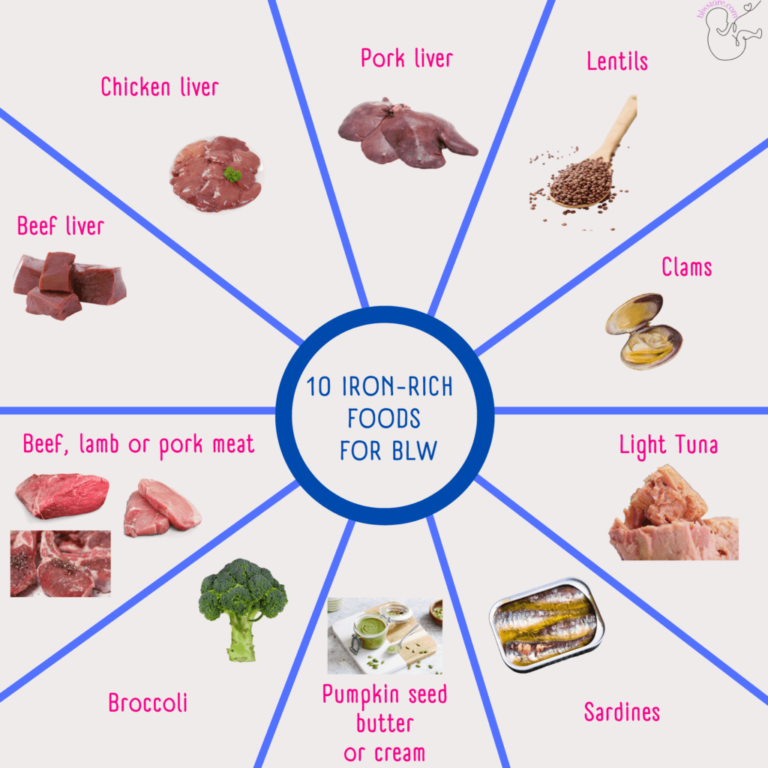
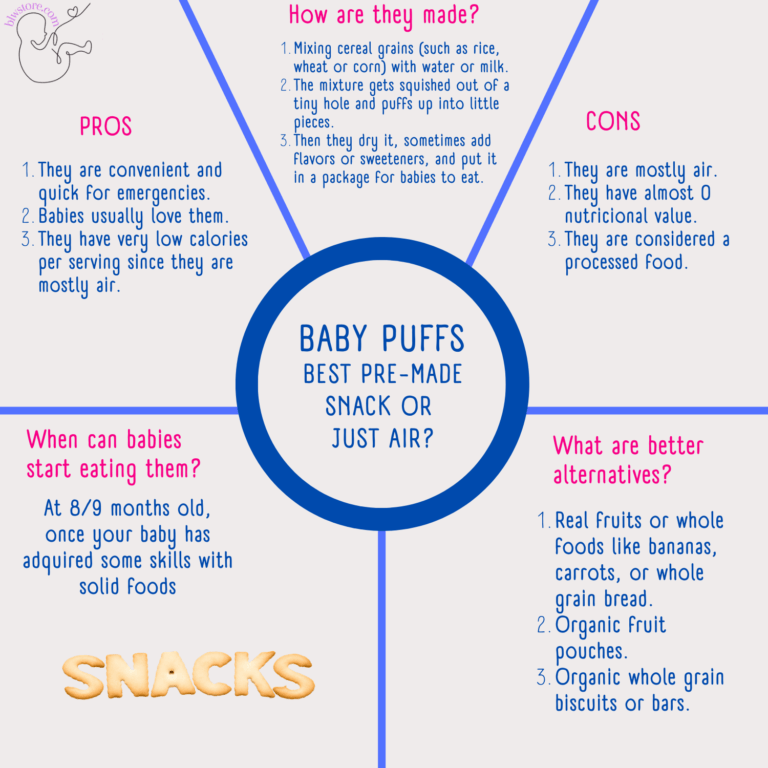
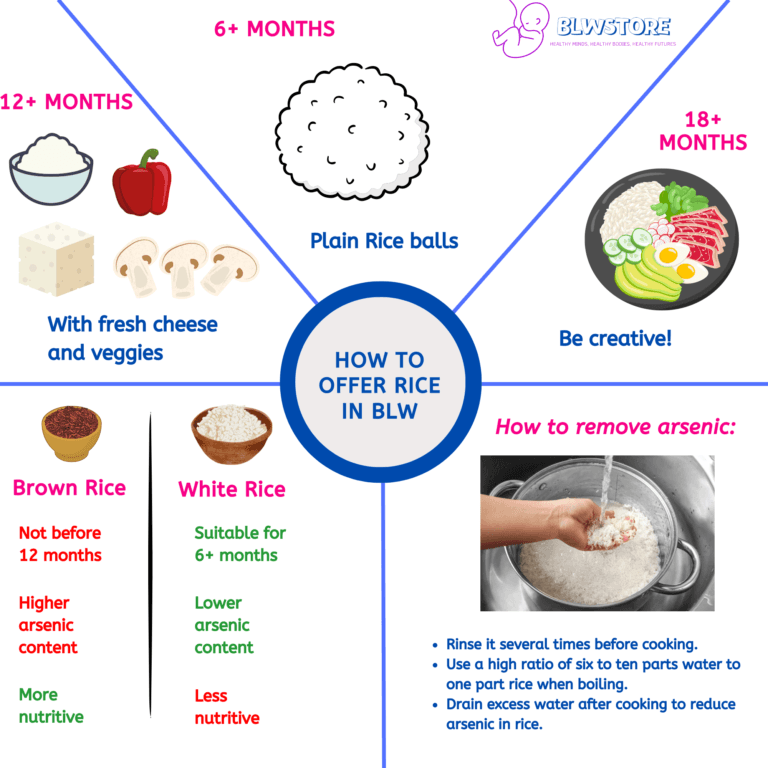
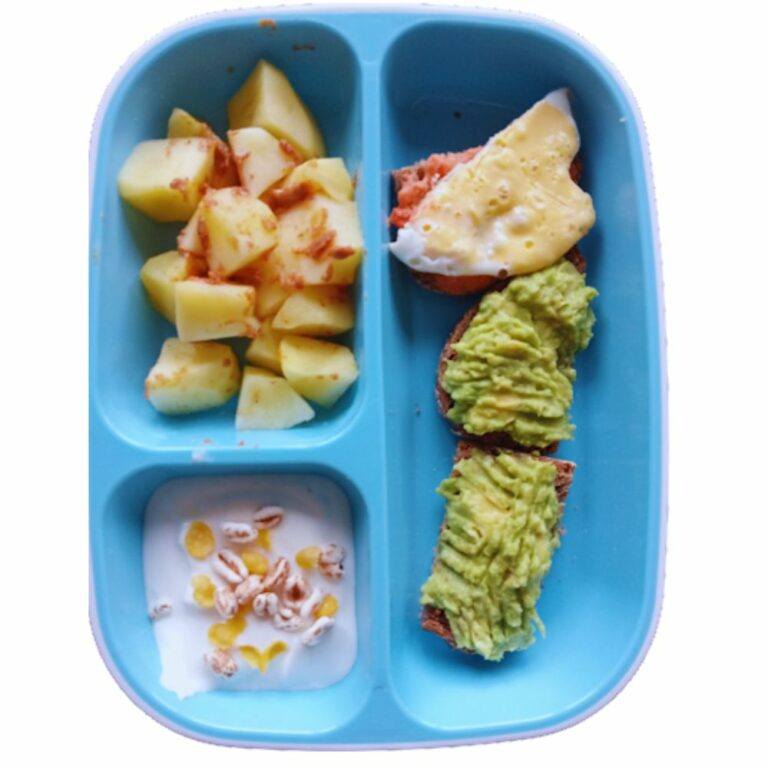
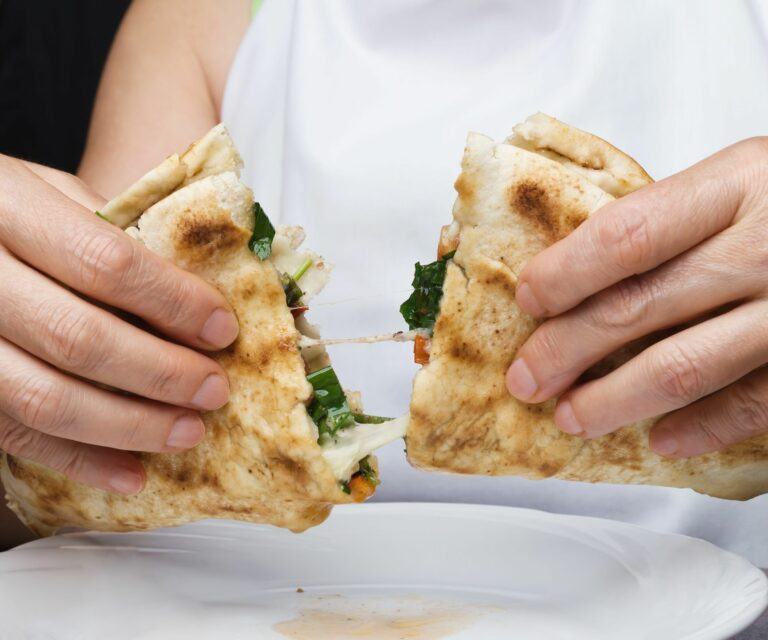
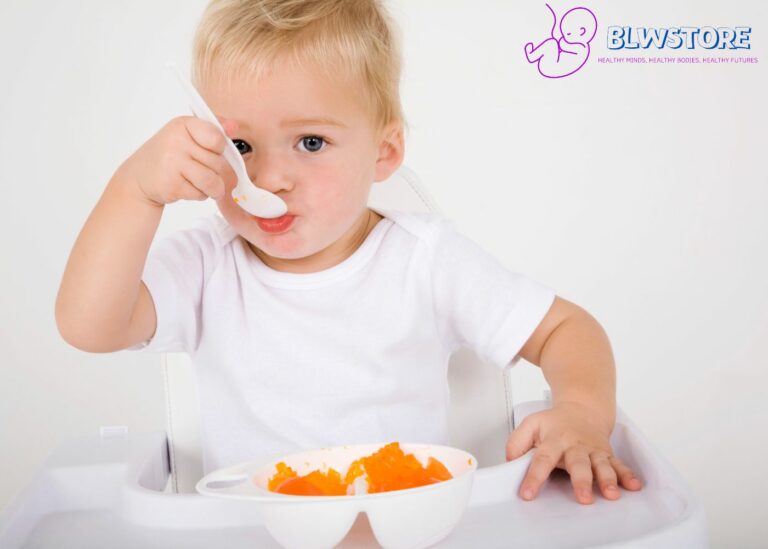
After examine just a few of the weblog posts on your website now, and I actually like your means of blogging. I bookmarked it to my bookmark web site record and will be checking again soon. Pls check out my web site as properly and let me know what you think.
Your article helped me a lot, is there any more related content? Thanks!
Delois, thank you so much for your comment; it means a lot.
This post has taken some time to create but it has been completely worth it! We just hope it helps parents who want to give BLW a try.
Thanks again!
You have a very well organized, informative step by step website for anyone that wants to introduce baby to solid foods. Opinions on when this is to happen has changed over the years. When I first came out of nursing school,1970’s all the pediatricians instructed parents to not feed solid food for a whole year, just formula. When the numbers of babies with “failure to thrive” diagnoses increased, the pediatricians dropped that “no solid food/year” consensus. Each baby is different in developmental stages and explaining to readers that working with pediatrician and observing your own baby’s readiness is good advice. Introducing “real” foods in soft form and one at a time is a good start to healthy eating. I did that with my children but now I see it has a name… BLW! The charts with steps and safety precautions are all well presented. I especially like the video giving instructions on what to do when baby is choking which is the main fear of not giving solid foods to baby. What a great website with recipes, instructions and encouragement for parents wanting to BLW!
Hi Bob,
Maria and I highly recommend trying Baby-Led Weaning. However, we understand that some parents may not feel comfortable with this approach. If so, you can always mix it with traditional feeding methods and gradually transition to solid foods as your baby becomes more skilled.
Hi Line,
When introducing new foods, it’s important to wait 1-2 days for non-allergenic foods and three days for potential allergens before submitting anything new, as you suggested.
Once several different foods have been introduced, maintaining variety is essential to allow the baby to experience and try different flavors and textures. This can help prevent picky eating behaviors in the future.
Thank you for your comment!
Hey, this post is really informative about baby-led weaning! I have a few friends who have tried this approach and have had great success. I have a question, do you think baby-led weaning is better than traditional spoon-feeding? I think it’s great that babies are able to explore different textures and tastes on their own, but I’m curious about the benefits compared to traditional feeding methods. I appreciate all the tips and information in the post, it’s definitely given me some food for thought (pun intended).
Many new parents wonder when they should introduce solid foods to their babies. So this is a very helpful guide on baby led weaning, and the first foods that can be introduced. And great to see that pureed foods can be combined with pieces of food.
I find it interesting that you suggest that one introduces a variety of foods, but if there is an allergy, would it not be difficult to know which one caused it? So is it better to just introduce one new food at a time and try it for a week before introducing another?